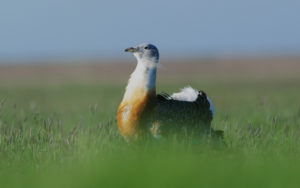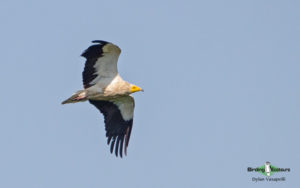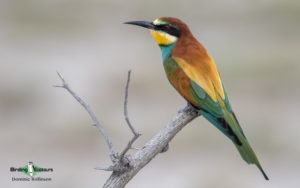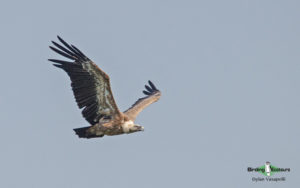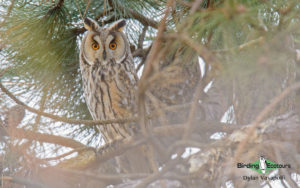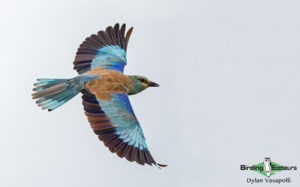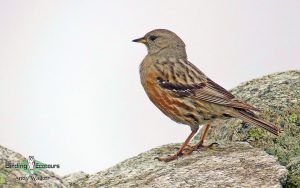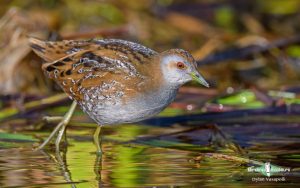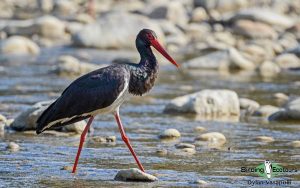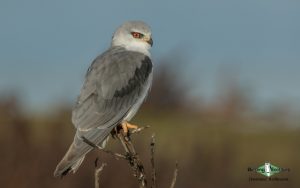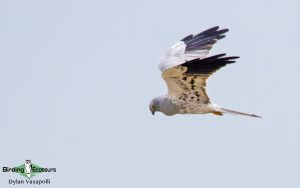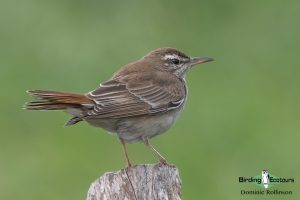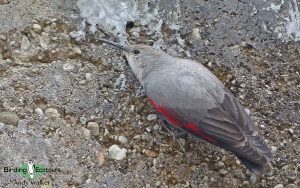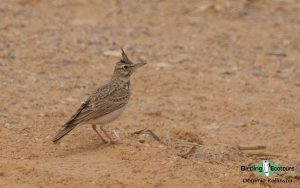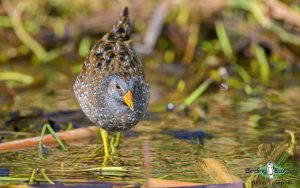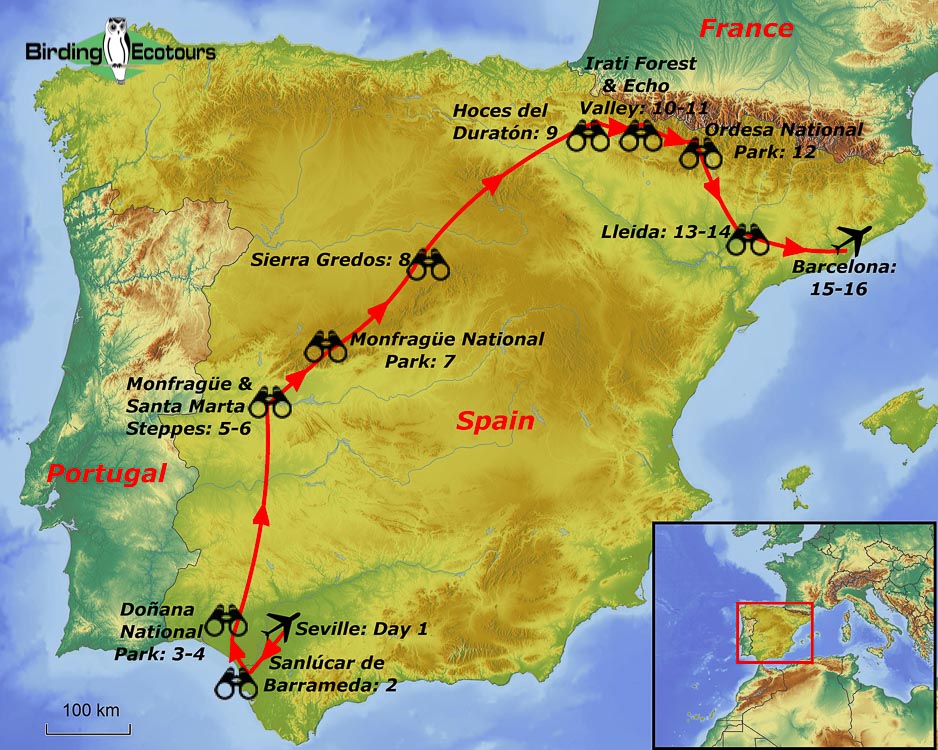Spain: Spring Birding Extravaganza
Go to: Spain Birding Tours | Birding Tours in Europe | All our birding tours
Spain Birding Tour: Spring Birding Extravaganza
April 2026
Spain is one of Europe’s birding wonders. It combines a sensational range of species with beautiful weather and stunning scenery. This spring birding extravaganza is perfectly timed to take in the exciting migration with a small group of like-minded birders. As our tour progresses, we will take in Spain’s vast interior with its breathtaking scenery, dotted with gorgeous white-painted classically Spanish villages. It is here that we will sample the finest avifauna that the country has to offer, including the excitement of up to 23 species of birds of prey! Our thorough itinerary covers a range of habitats from the famous coastal areas of Doñana National Park to the semi-arid steppe of the interior and the high peaks of the Pyrenees. This will enable us to see the true variety that Spain has to offer the visiting birdwatcher. The timing of our visit during the spring passage migration will also enable us to maximize the sheer number of species on offer.
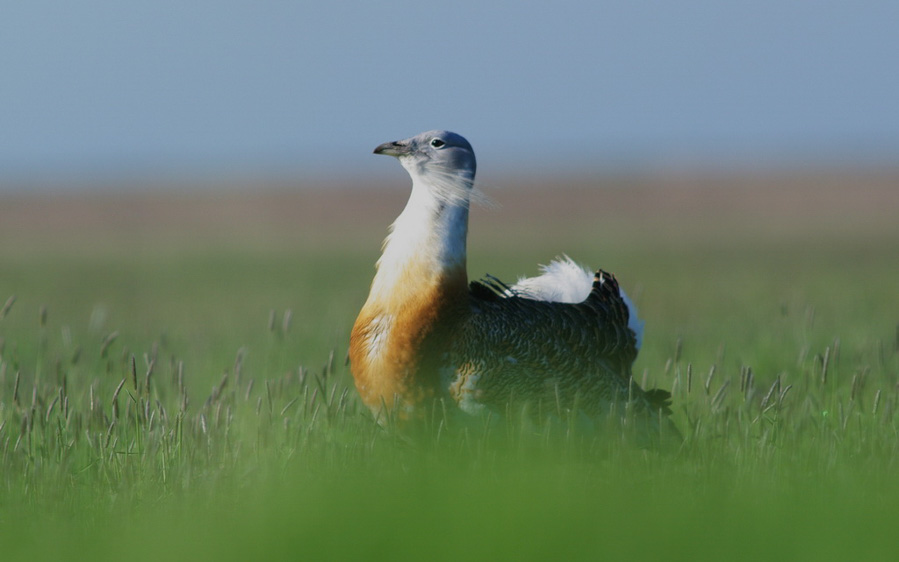
Spain’s bird list currently stands at 672 species (following International Ornithological Congress (IOC) v13.1 taxonomy as of July 2023), one of the highest single country lists in the Western Palearctic, and this results in a typically high total of well over 200 species regularly recorded on this tour. The combination of expert guides, a comprehensive itinerary visiting the best places to go birding in Spain, as well as visiting at the best time of year, will result in some wonderful avian experiences.
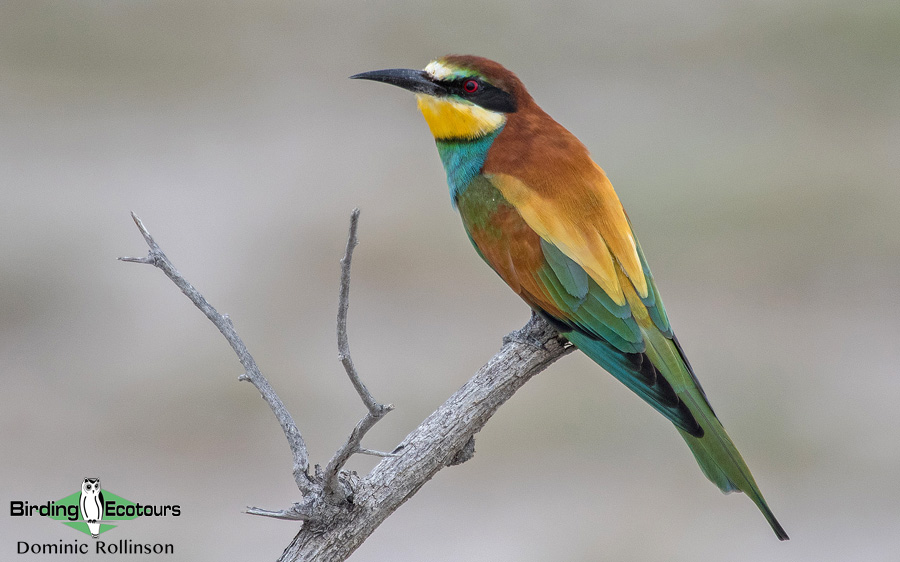
We begin our tour in the surrounds of the Guadalquivir river and the famous Doñana National Park where we will visit the bird rich habitats of this wonderful area. This is a great way to kick off our tour with classic Mediterranean species such as Spanish Imperial Eagle, Black-winged Kite, Collared Pratincole, White-headed Duck, Red-knobbed Coot (Critically Endangered on the Red List of Spain (BirdLife International), and the only population in Europe), Marbled Duck, Red-crested Pochard, the newly described Mediterranean Short-toed Lark (formally Lesser Short-toed Lark), Lesser Kestrel, Montagu’s Harrier, Iberian Magpie (formerly Azure-winged Magpie), and Western Swamphen all targeted, along with many other species. Rarer species in the form of Little Swift and Lesser Crested Tern will add to the spectacle as will a visit to the land of the world’s rarest large cat, Iberian Lynx. While sightings of this elusive predator are by no means guaranteed we will visit the best areas possible to give us a chance of an encounter with this mystical feline.
We then move north through the beautiful Spanish countryside towards Monfragüe National Park and the surrounding steppes and sierras. This area gives us a chance to explore some of Spain’s special steppe species such as Great Bustard, Little Bustard, Black-bellied Sandgrouse, Pin-tailed Sandgrouse, European Roller, Eurasian Stone-curlew, and Great Spotted Cuckoo. This beautiful area is also prime raptor country, and here we will be in search of Egyptian Vulture, Cinereous Vulture, Griffon Vulture, Spanish Imperial Eagle, Booted Eagle, and Short-toed Snake Eagle. The national park is home to many other fabulous species including Black Stork, Blue Rock Thrush, Western Black-eared Wheatear, and Western Orphean Warbler. We will also get our first taste of mountain birding in the Sierra de Gredos. Here we will look for Ortolan Bunting, Water Pipit, Common Rock Thrush, Bluethroat, White-throated Dipper, European Crested Tit, Citril Finch, and Red-backed Shrike, a species which is becoming increasingly rare in Spain. We continue our northward journey to the plains north of Madrid. Here we will target the mystical Dupont’s Lark, which is best found in the early morning light of spring. This area is also superb for other larks such as Greater Short-toed Lark, Calandra Lark, Crested Lark, and Thekla’s Lark. Other key species of the area are Common Quail, Iberian Grey Shrike, and Tawny Pipit.
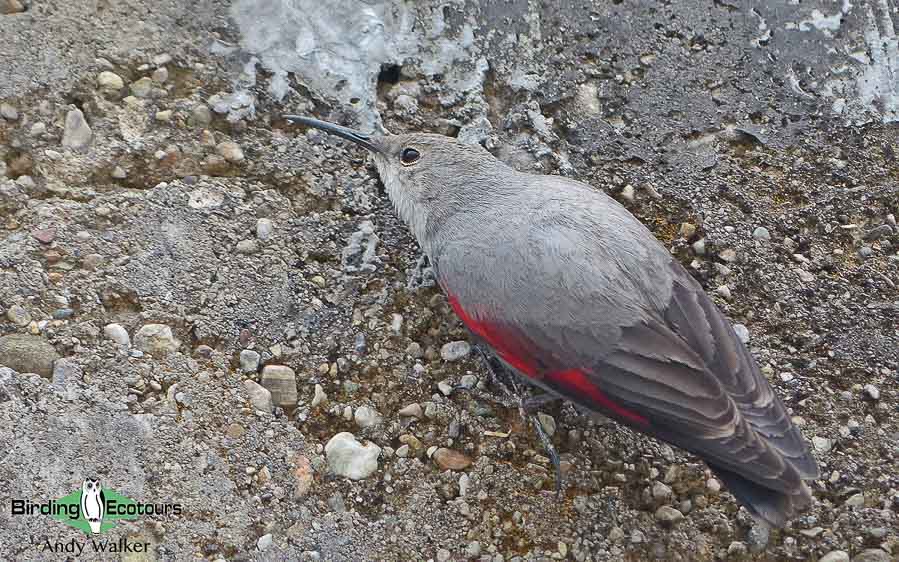
We then take our long journey to the Pyrenees with woodpeckers our first targets. By using expert local guides, we will search for Middle Spotted Woodpecker, Black Woodpecker, and the incredibly rare (in this part of Europe) White-backed Woodpecker. We then proceed further into the vast Pyrenean wilderness looking for the iconic Bearded Vulture, a true highlight of a visit to the region. We will continue to explore this breathtaking part of Europe and target the key species of the high Pyrenees. Along with Bearded Vulture we will spend time in search of the beautiful Wallcreeper (a monotypic family). The area that supports this species is also a great place to yet again search for Red-backed Shrike plus other key species for the region such as Black Woodpecker, Marsh Tit, Garden Warbler, Eurasian Treecreeper, Yellowhammer, Ring Ouzel, Rock Sparrow, Eurasian Wryneck, Alpine Chough, and Alpine Accentor. With luck we may also spot Southern Chamois, a species of goat-antelope, and the very adorable Alpine Marmot, a species of ground dwelling squirrel. We finish our Pyrenean adventure with a visit to the high plateaus and dramatic glacial valleys of the Ordesa y Monte Perdido National Park. Here we will target some of the previously mentioned montane species plus the striking White-winged Snowfinch.
Sadly, all good things must come to an end and the final leg of our tour will see us link up with a local guide to look for the often hard to find Moustached Warbler and Bearded Reedling (Bearded Tit) in the area around Lleida. We finish with a visit to the Delta de Llobregat near Barcelona which will give an excellent range of wetland species and migrants, the perfect way to end our spring birding extravaganza.
If you wanted to spend more time in the region, why not join us for our Birding Tour Morocco: Best of Northwest Africa tour which runs immediately prior to this Spain tour. Our Morocco birdwatching tour takes in the country’s highlight birds and best birding sites. Top target birds in Morocco include Levaillant’s Woodpecker, Houbara Bustard, Moussier’s Redstart, Northern Bald Ibis, Barbary Partridge, Cream-colored Courser, Egyptian Nightjar, White-rumped Swift, Dark Chanting Goshawk, Blue-cheeked Bee-eater, Black-crowned Tchagra, Maghreb Magpie, African Blue Tit, Fulvous Babbler, Atlas Pied Flycatcher, Desert Sparrow, African Crimson-winged Finch, and Trumpeter Finch, plus multiple species of owls, warblers, larks, and sandgrouse. There will also be a great selection of migrants building up in Morocco before they continue their journey from sub-Saharan Africa to their breeding grounds in Northern Europe.
You can also join us for our 14-day Birding Tour Poland: Best of Eastern Europe tour straight after this Spain tour. These two tours complement each other brilliantly, as you will have the opportunity to add a vast array of superb species from Eastern Europe to those you have just seen in Western Europe. Highlight species in Poland include Great Snipe, White-winged Tern, Aquatic Warbler, Icterine Warbler, River Warbler, Barred Warbler, Citrine Wagtail, Lesser Spotted Eagle, Greater Spotted Eagle, Red-footed Falcon, Ural Owl, Eurasian Pygmy Owl, Eurasian Three-toed Woodpecker, Spotted Nutcracker, Red-breasted Flycatcher, Collared Flycatcher, and so much more. We also have a good chance of seeing some of Europe’s top mammals which include European Bison, (Eurasian) Grey Wolf, Eurasian Lynx, and (European) Brown Bear.
If you cannot make the dates of this scheduled tour please get in touch and we would be happy to help build a custom tour with dates to suit you.
Itinerary (16 days/15 nights)
Day 1. Arrival in Seville
Welcome to Andalusia! You will be met at Seville San Pablo Airport by your Birding Ecotours tour leader and local Spanish bird guide. Once the whole group has arrived we will meet at our hotel to discuss the trip itinerary and use the time to facilitate with anything the group may need, or just relax after your flight before the trip starts and we head into more remote areas of the country. We will have a group ‘welcome meal’ in the evening.
Overnight: Hotel in Seville
Day 2. Birding around Sanlúcar de Barrameda
Our first full day of the tour will see us explore the superb area around Spain’s second longest river, the Guadalquivir. Throughout the day we will visit three bird rich sites that offer great variety and experiences.
The first site we are likely to visit is the Bonanza Saltpans. This expansive saltpan site is superb for shorebirds (waders) and we will spend some time here looking for species such as Little Stint, Curlew Sandpiper, Black-winged Stilt, Little Ringed Plover, Pied Avocet, Eurasian Whimbrel, Kentish Plover, Sanderling, Ruff, Common Redshank, and Dunlin.
The area is also excellent for two rare waterbirds, the Endangered White-headed Duck and the Critically Endangered (in Spain), Red-knobbed Coot (BirdLife International). The entire European population of the coot is found in Spain and even here it is incredibly rare. Greater Flamingo is a common species here and we will visit a nearby heronry where we can find a variety of Pelecaniformes such as Black-crowned Night Heron, Squacco Heron, Western Cattle Egret, Purple Heron, and Eurasian Spoonbill.
The second site in the area will see us explore the habitats bordering the Guadalquivir river. It is here we will search for two key species in the form of Marbled Duck (another very localized species in Europe) and Mediterranean Short-toed Lark, two species that are hard to come by elsewhere in Spain. The vineyards around the area are a good spot to look for Eurasian Hoopoe, Lesser Kestrel, and Montagu’s Harrier, and the timing of our tour may allow us to catch up with the striking Rufous-tailed Scrub Robin, which breeds here.
Our final site in the area is the Port of Chipiona. Famed for its superb seafood the town also holds the only European colony of the strikingly black-and-white plumaged Little Swift. While common on the other side of the Mediterranean in Morocco this species is a real European mega rarity, and we will take some time enjoying the nesting colony. The beach nearby can be excellent for shorebirds, gulls, and terns including rare species such as Lesser Crested Tern.
Overnight: Palacio de Arizón, Sanlúcar de Barrameda
Day 3. Sanlúcar de Barrameda to El Rocio
Depending on our success on day two we will either spend some time in the morning around Sanlúcar de Barrameda or proceed directly to the superb Brazo del Este wetlands to the north. This protected area near the city of Seville is a superb habitat for shorebirds and waterbirds, plus passerines such as Savi’s Warbler and Great Reed Warbler. We also stand a chance of adding some elusive crakes to our list with Spotted Crake, Little Crake, and Baillon’s Crake all present here.
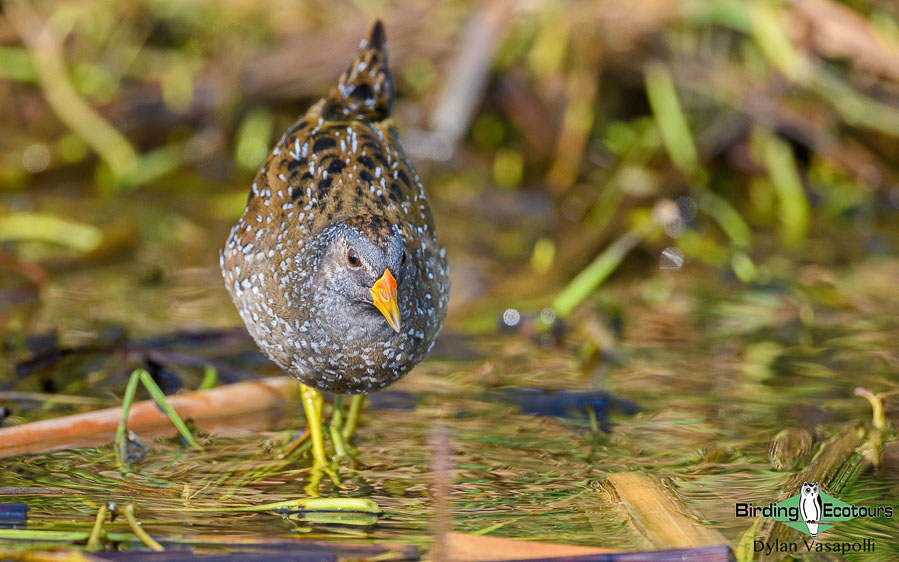
As we proceed through the site, we will spot significant numbers of Western Swamphen, Purple Heron, Squacco Heron, Collared Pratincole, Whiskered Tern, and many more species typical of this habitat. We should also get some introduced species from Africa that have established themselves in the area such as Black-headed Weaver, Yellow-crowned Bishop, and Common Waxbill.
In the afternoon we visit Dehesa de Abajo and Dehesa Las Hermosillas on the borders of Doñana National Park. At these sites we have another chance of Red-knobbed Coot, Marbled Duck, Red-crested Pochard, and possibly Ferruginous Duck. We can then proceed to Dehesa Torneros which is a beautiful area in spring with large numbers of wildflowers. This habitat is excellent for Common Cuckoo, Sardinian Warbler, European Serin, Corn Bunting, European Stonechat, and other common passerines. The real bonus of this area is that we will be in the land of the Iberian Lynx and we will spend time looking for this elusive big cat.
After dinner we will search the grounds of our hotel looking for Red-necked Nightjar, Tawny Owl, and Long-eared Owl.
Overnight: Ardea Purpurea, Villamanrique de la Condesa
Day 4. El Rocio
This morning we will visit the lagoon of El Rocio and surrounding sites of La Rocina, El Acebrón, and El Acebuche. This is a superb area for species that are otherwise hard to find in this part of Spain and we will spend time searching for Lesser Spotted Woodpecker, Iberian Green Woodpecker, Eurasian Golden Oriole, Dartford Warbler, Iberian Chiffchaff, and Iberian Magpie. Iberian Magpie was formally called Azure-winged Magpie, with two disjunct populations, however this species has now been split into two species, with birds in China remaining as Azure-winged Magpie (we see these on our China: Sichuan tour), and birds in Iberia gaining the new name. They are both beautiful birds.
In the afternoon we will head towards Centro de Visitantes Jose Antonio Valverde. This is a superb birding area where we will be in the prime habitat of Spanish Imperial Eagle plus other highlight raptor species such as Montagu’s Harrier and Black-winged Kite. The lagoon and wetland areas here will give us a variety of species such as Greater Flamingo, Collared Pratincole, and Squacco Heron.
Overnight: Ardea Purpurea, Villamanrique de la Condesa
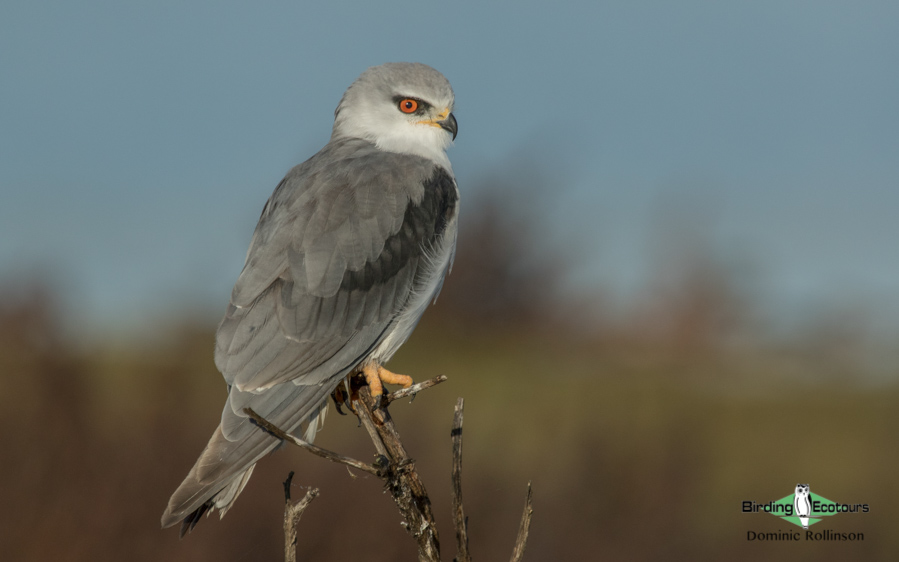
Day 5. El Rocio to Monfragüe
Our day will start with a short birding session at Bollullos Par del Condado. This area is our last stop in Andalusia and could be our last chance of seeing the stunning Montagu’s Harrier. Unfortunately, this species has declined rapidly in the neighboring region, and our next destination, Extremadura, so this gives us one last chance of seeing this iconic Mediterranean species. Our tour should also be timed perfectly to coincide with the arrival of Rufous-tailed Scrub Robin and we will search this area for them as well.
Afterwards we will commence the journey north through the beautiful Spanish countryside towards Monfragüe. On the route we will stop at Alange Reservoir in Badajoz to search for Black Wheatear, Egyptian Vulture, Bonelli’s Eagle, Woodchat Shrike, Black Kite, Western Black-eared Wheatear, Eurasian Scops Owl, and Gull-billed Tern.
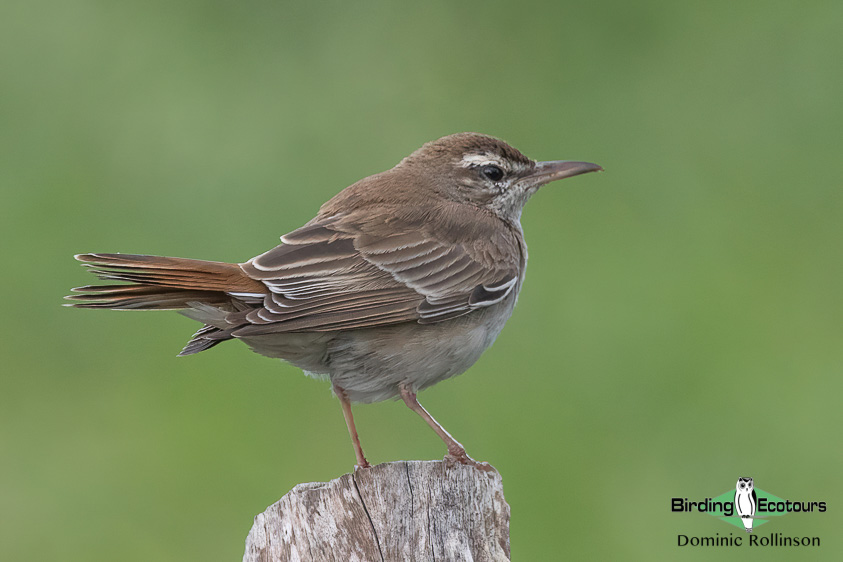
After this stop we continue our journey north towards Monfragüe. Depending on our time of arrival we can visit one or two sites close to our hotel. One site is Jaraicejo where the star species is the tiny Spectacled Warbler, a rather cute Sylvia warbler. Other Sylvia warblers present here include Western Subalpine Warbler and Dartford Warbler. Sylvia warblers are part of the Sylviidae family (now Sylviid Babblers) and are Europe’s answer to the colorful New World Warblers, the Parulidae family of the Americas. Additional key species in this bird rich area include Black Stork, Spotless Starling, Eurasian Crag Martin, Red-rumped Swallow, Short-toed Snake Eagle, Booted Eagle, Eurasian Hoopoe, Common Nightingale, Cirl Bunting, Spanish Sparrow, Western Bonelli’s Warbler, European Turtle Dove, Iberian Grey Shrike, Thekla’s Lark, Short-toed Treecreeper, Greater Short-toed Lark, and European Bee-eater.
Another nearby site is Almaraz where we have a chance of spotting the huge and equally striking Eurasian Eagle-Owl. This apex predator is a highlight of any tour and a sighting of one will be a great way to end the day.
Overnight: Hospederia de Monfragüe, Torrejón el Rubio
Day 6. Monfragüe to Santa Marta steppes
We will spend the full day exploring the Santa Marta steppes. This beautiful area is our best chance of the tour to spot some of the many iconic species of the steppe habitat. We will have plenty of time looking for Great Bustard, Little Bustard, Black-bellied Sandgrouse, Pin-tailed Sandgrouse, European Roller, Eurasian Stone-curlew, and Great Spotted Cuckoo.
Overhead the sight and sound of European Bee-eaters will likely fill the air and other steppe species such as Iberian Grey Shrike, Black Kite, Lesser Kestrel, Crested Lark, Calandra Lark, Greater Short-toed Lark, Eurasian Hoopoe, Corn Bunting, and European Stonechat will add variety to a day focused on the real specials of this area.
Overnight: Hospederia de Monfragüe, Torrejón El Rubio
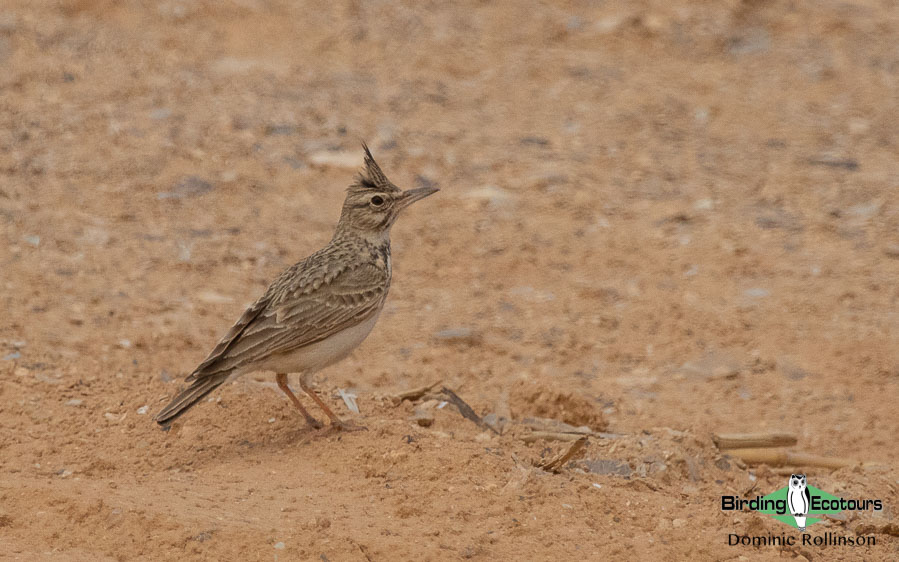
Day 7. Monfragüe to Gredos
Our second day in Monfragüe will take us to Monfragüe National Park itself before we continue our journey north to Gredos. The majestic scenery and fabulous wildlife here make this a real highlight of the tour. The national park is a mecca for birds of prey with Egyptian Vulture, Cinereous Vulture, Griffon Vulture, Short-toed Snake Eagle, Booted Eagle, Bonelli’s Eagle, Spanish Imperial Eagle, Golden Eagle, Red Kite, Black Kite, Common Buzzard, Osprey, Lesser Kestrel, Common Kestrel, Eurasian Hobby, Peregrine Falcon, Eurasian Sparrowhawk, Eurasian Goshawk, Black-winged Kite, and Montagu’s Harrier all recorded in the area during spring. While some of these species are more common than others, we will have a fantastic day in the national park, taking in its many birds of prey.
However, it is not all just about birds of prey here as many other star species call the national park their home. These include Black Stork, Blue Rock Thrush, Western Black-eared Wheatear, Western Orphean Warbler, Alpine Swift, Thekla’s Lark, Eurasian Crag Martin, Red-rumped Swallow, Western Subalpine Warbler, Rock Bunting, Cirl Bunting, Iberian Grey Shrike, Northern Wheatear, Eurasian Golden Oriole, Zitting Cisticola, Melodious Warbler, Iberian Chiffchaff, Short-toed Treecreeper, Spanish Sparrow, Hawfinch, and Rock Sparrow.
Overnight: Hostal Almanzor, Navarredonda de Gredos
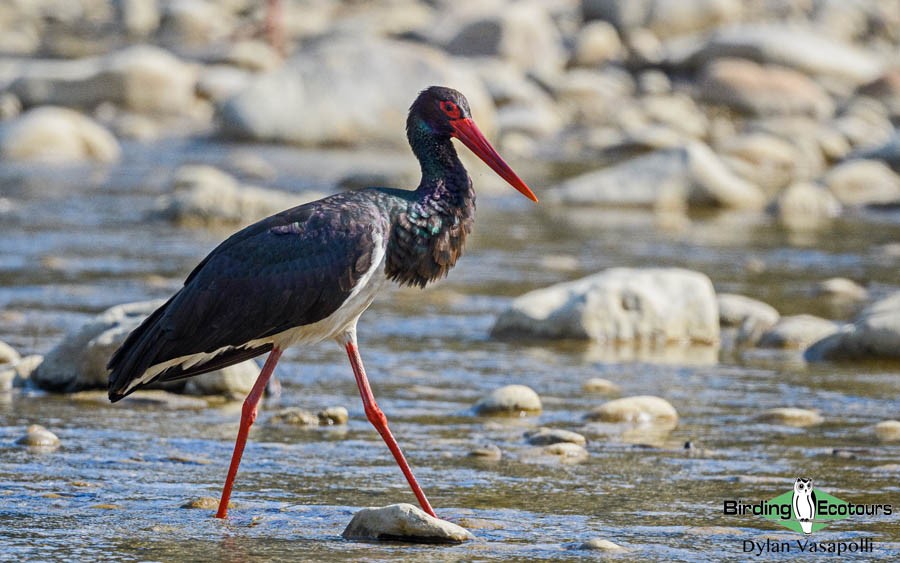
Day 8. Gredos to Hoces del Duratón
Our day will begin with a pre-breakfast visit to the hotel bird blind (hide) where we could get close views of Great Spotted Woodpecker, Red (Common) Crossbill, and Eurasian Nuthatch, plus common garden species of the area such as Eurasian Blue Tit, Great Tit, House Sparrow, European Goldfinch, and European Greenfinch.
After breakfast we will continue our day by driving up to La Plataforma which sits at 5,800 feet (1,770 meters) above sea level. Here we will enjoy stunning scenery along with some excellent bird species such as Ortolan Bunting, Northern Wheatear, Water Pipit, Eurasian Skylark, Common Rock Thrush, Bluethroat, and Red-backed Shrike, a species which is becoming incredibly rare in Spain. We will also explore the nearby forests for White-throated Dipper, Goldcrest, European Crested Tit, and Citril Finch.
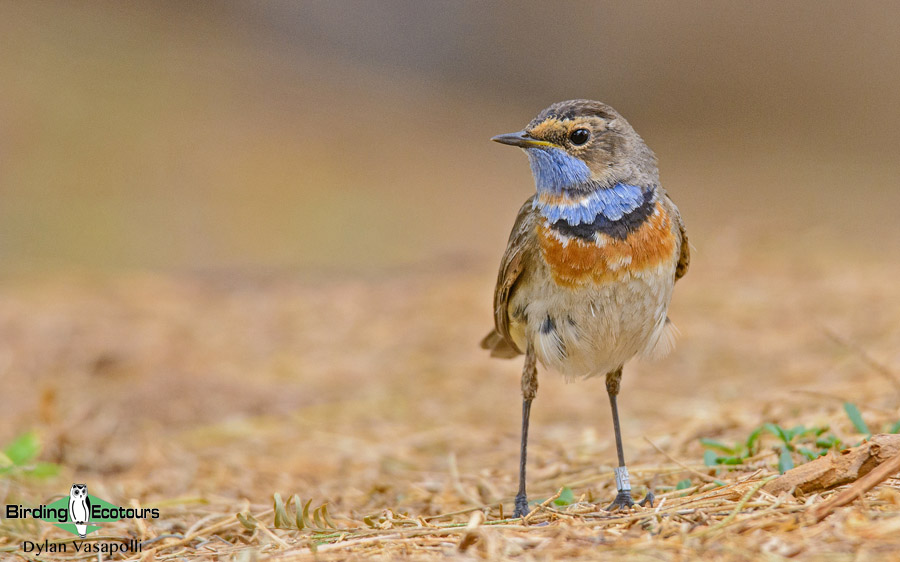
We are also in suitable terrain to search for Iberian Ibex. This fantastic-looking goat is split into four subspecies, two of which are extinct, with the subspecies in the Gredos area being known as Western Spanish (Gredos) Ibex.
In the afternoon we head northeast towards the Hoces del Rio Duratón National Park. If time allows, we will make our first attempt at the incredibly elusive Dupont’s Lark. BirdLife International list this bird as being of globally Near Threatened status and it has declined rapidly in many areas. It has always been a highly prized species, but that status is becoming more relevant than ever in recent years.
Overnight: Rincón de las Hoces, Burgomillodo
Day 9. Hoces del Duratón to Irati
Today will see us make an early morning start as we go in search of Dupont’s Lark at Hoces del Duratón. As previously mentioned, this is a highly prized species and our best chance of seeing it will occur in the early morning as they perform their beautiful song. This area is generally excellent for larks and we could come across Greater Short-toed Lark, Calandra Lark, Eurasian Skylark, Crested Lark, and Thekla’s Lark here. Other star birds of the area include Common Quail, Common Cuckoo, Iberian Grey Shrike, and Tawny Pipit.
After breakfast we will prepare ourselves for the drive of around four hours to the Pyrenees mountains. Depending on time we have two options for this journey and your guides will discuss this with you at the time. Both routes offer the opportunity of good birding with the southern route giving us the opportunity to look for the highly sought-after Middle Spotted Woodpecker.
After our drive we will arrive in the village of Ecay de Lónguida which sits nestled in the foothills of the Pyrenees just 20 miles (32 kilometers) from the border with France.
Overnight: Hotel Ekai, Ecay de Lónguida
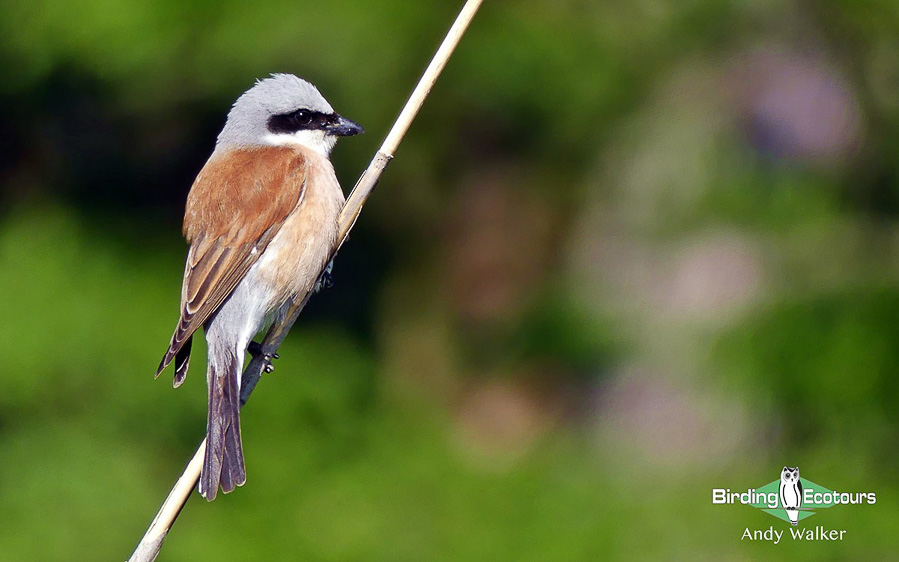
Day 10. Irati to Echo
We will join forces with local guides to search for several woodpeckers which are found in the areas of Irati Nature Reserve and Quinto Real. We will once again target Middle Spotted Woodpecker, but it is Black Woodpecker and White-backed Woodpecker which are the two most-prized species here. These are both incredibly difficult to see anywhere in Spain and to see both species would be a superb start to the day. We will give plenty of time to look for all three species while being aware that we have another chance of getting Black Woodpecker later in the tour.
The afternoon will be spent driving to the breathtaking Echo valley. This area is extremely popular with climbers, but it is also a superb birding area and it is here that we will look for the iconic Bearded Vulture. This species of vulture is a star bird of the region and we will have several opportunities to connect with it.
Overnight: Hotel de Montaña Usón, Echo
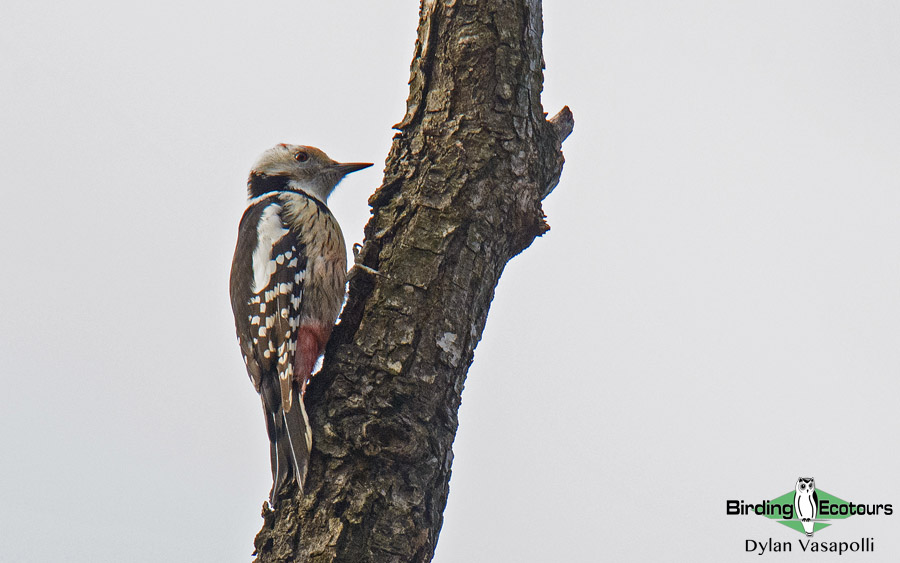
Day 11. Echo
We will once again explore the Echo valley and its surrounding areas. We begin at Gabardito in the high Pyrenees where, along with Bearded Vulture, our primary target will be the outrageous Wallcreeper. This species is monotypic meaning it is the only species in its family and it is a highly prized bird for visitors to the region. We will then head to the forests nearby to search for Black Woodpecker, once again, and also for other forest species such as Marsh Tit, Garden Warbler, and Eurasian Treecreeper, the latter of which does not occur further south in Spain. We will continue our high-altitude birding at Guarrinza and La Mina which are a stone’s throw from the border with France. Here we will target species such as Yellowhammer, Red-backed Shrike, and Alpine Chough. There are also two exciting mammal species here. The first is Alpine Marmot which is a species of ground squirrel and can be seen scurrying around the rocky outcrops of the area. The second is the rare Southern Chamois, a species of goat-antelope, which favors high mountain areas. Its population numbers just 50,000 individuals but is thankfully increasing.
After a day exploring the high Pyrenees we will return to Echo for the night.
Overnight: Hotel de Montaña Usón, Echo
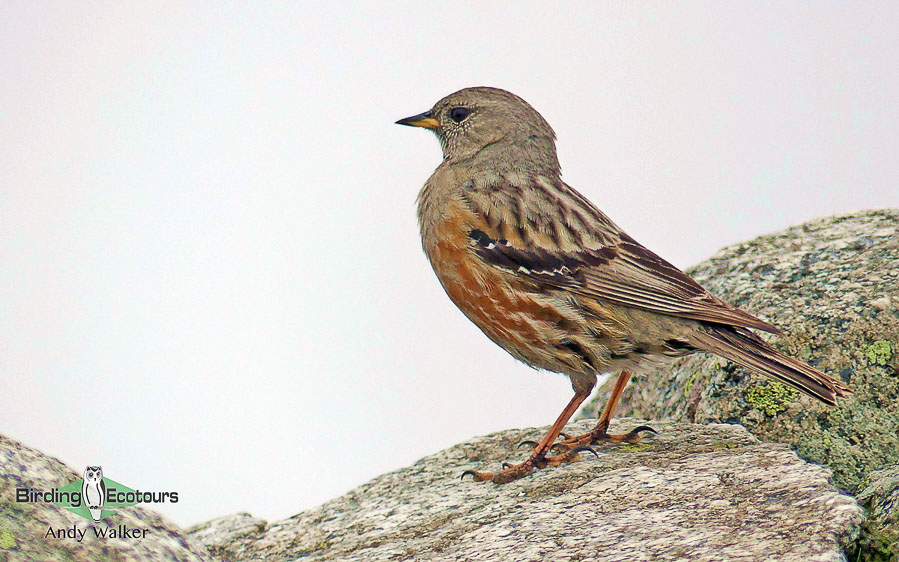
Day 12. Echo to Ordesa y Monte Perdido National Park
Depending on the success of the previous days we will have the ability to be flexible today. In the morning we can attempt to spot Wallcreeper, once again, in case we missed it during previous searches. If we have already had success with this iconic species, then we can spend the morning in the Baztan valley for species like Red-backed Shrike and Marsh Tit. If time permits, we could spend the full day in this valley and climb its neighboring peaks to the French border to look for high-altitude specials such as Ring Ouzel (alpestris subspecies) and Alpine Accentor.
If we spend the morning in this area, we will make the journey towards Ordesa in the afternoon. En route we will stop to spot some species we may have missed so far. We will be in the prime habitat of Eurasian Wryneck, Western Subalpine Warbler, Rock Sparrow, Common Chiffchaff, and Ortolan Bunting. This area is also good for Black Woodpecker, if we have not already connected with this species.
Overnight: Hotel Palazio, Nerín
Day 13. Ordesa to Lleida
Today we will exchange our tour bus for 4×4 vehicles as we head into the Ordesa y Monte Perdido National Park. This is the only way to reach this high-altitude area and we will spend the day at around 8,200 – 9,800 feet (2,500 – 3,000 meters) above sea level. This is the Pyrenees Mountains at their largest and the breathtaking Monte Perdido, the third highest peak in the Pyrenees, will tower over us, it is a spectacular site to be birding.
We will spend the day on the high plateau and view the glacial valley of Ordesa in all its majesty. It is here we will once again find high-altitude bird species with White-winged Snowfinch being the star of the show. This stunning species is joined in its mountain home by Alpine Accentor, Ring Ouzel (alpestris subspecies), Alpine Chough, Water Pipit, White-throated Dipper, Eurasian Crag Martin, Rock Bunting, Black Redstart, and Rock Sparrow. We may get lucky and have Griffon Vulture and Bearded Vulture soar overhead, once more, as we descend through the valley stopping to look for other species that favor this valley.
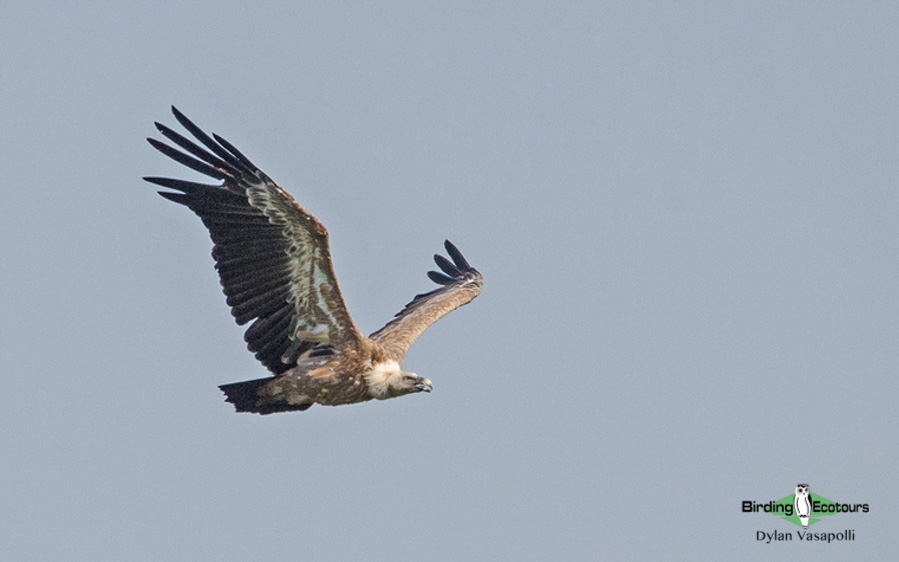
With our lungs filled with fresh mountain air and our cameras full of stunning photos we will begin the descent out of the Pyrenees. We will travel south into the heartland of Lleida, the penultimate region we visit on our tour.
Overnight: Ibis Hotel, Lleida
Day 14. Lleida
We will once again team up with a local guide to try and seek out some of the area’s species that we may have missed previously. In addition, we will also look for two species which can prove very tricky. Moustached Warbler is one of these, and this species of Acrocephalus warbler can be exceptionally elusive as it moves through its preferred dense reedbed habitat. The second is the striking Bearded Reedling (Bearded Tit), another species which can be elusive. This bird is often heard before it is seen, with its characteristic “ping” call a great indicator that a group is nearby.
We will once again overnight in the town of Lleida.
Overnight: Ibis Hotel, Lleida
Day 15. Lleida to Barcelona
The penultimate day of this exciting tour will see us spend the morning driving from Lleida into the Catalan capital of Barcelona. This stunning city also has the fantastic Delta de Llobregat on its doorstep, and it is here we will spend the day birding. This area is a fantastic spot for shorebirds (waders), wetland birds, and spring passage migrants making their way north. Species of note for this site include Red-crested Pochard, Black-winged Stilt, Pied Avocet, Kentish Plover, Common Ringed Plover, Little Ringed Plover, Eurasian Whimbrel, Yellow-legged Gull, Whiskered Tern, Purple Heron, Squacco Heron, Western Cattle Egret, Black-crowned Night Heron, Glossy Ibis, Great Reed Warbler, European Serin, Greater Flamingo, Water Rail, and Western Swamphen.
It is also a great site for picking up migrant passerines, particularly warblers and we may come across Wood Warbler, Spotted Flycatcher, European Pied Flycatcher, Sedge Warbler, Common (Eurasian) Reed Warbler, Western Bonelli’s Warbler, Willow Warbler, Eurasian Blackcap, Garden Warbler, Western Subalpine Warbler, Sardinian Warbler, Common Whitethroat, Common Nightingale, Common Redstart, Northern Wheatear, and Western Yellow Wagtail.
The site is also a good lure for rarer species and in recent springs this part of Spain has seen eruptions of Collared Flycatcher, a rare vagrant that moves from Africa to eastern Europe (we often see this gorgeous bird on our Greece tour for example).
Overnight: Hotel in Barcelona
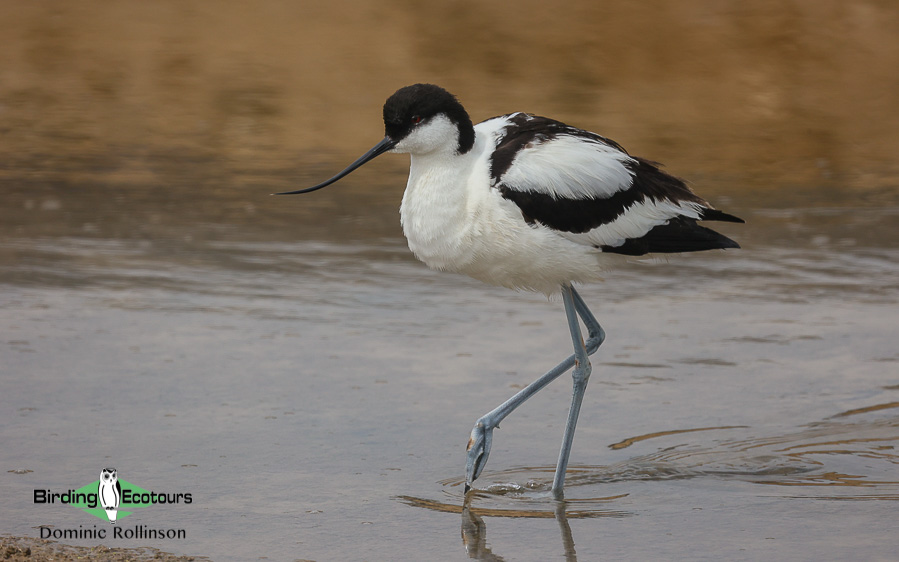
Day 16. Barcelona where tour concludes
Non-birding day. After a leisurely breakfast at our hotel we will head to Josep Tarradellas Barcelona-El Prat Airport to connect you with your flight home or for some further travel (such as our Birding Tour Poland: Best of Eastern Europe tour, to really maximize your birding visit to Europe).
Prior to leaving Barcelona, your guide will be on hand to answer any questions relating to the trip list or identification of species we have seen on the tour and we will have the important task of deciding ‘bird of the trip’, not an easy one, as we will have seen some absolute crackers.
Overnight: Not included
Please note that the itinerary cannot be guaranteed as it is only a rough guide and can be changed (usually slightly) due to factors such as availability of accommodation, updated information on the state of accommodation, roads, or birding sites, the discretion of the guides and other factors. In addition, we sometimes must use a different international guide from the one advertised due to tour scheduling.
Download ItinerarySpain: Spring Birding Extravaganza Trip Report, April 2023
12–27 APRIL 2023
DOWNLOAD TRIP REPORT
Overview
Our 16-day tour of Spain began on the 12th of April 2023, in the ancient city of Seville, and concluded on the 27th of April 2023 in Barcelona. During the tour we visited many wonderful birding locations including Brazo del Este, Doñana National Park, Monfragüe National Park, Sierra de Gredos, Ordesa y Monte Perdido National Park, and Delta del Llobregat.
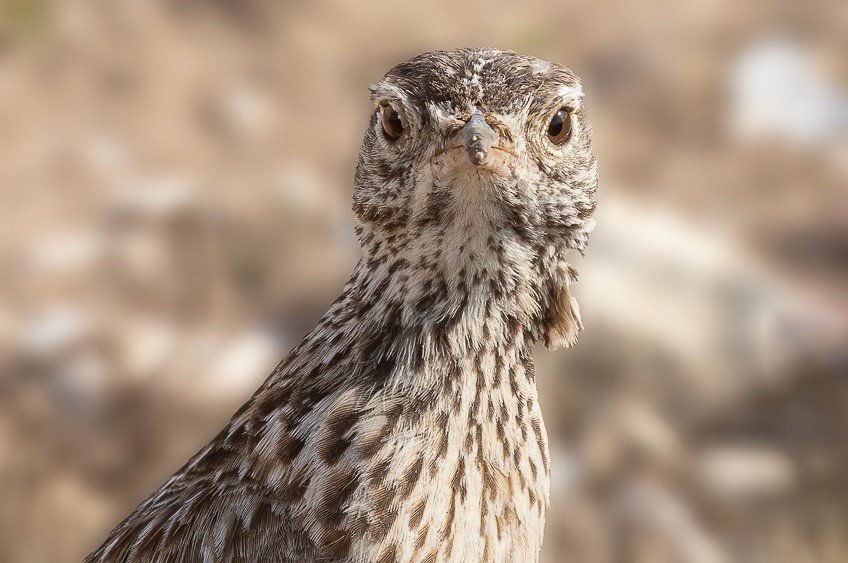
The views provided by the elusive Dupont’s Lark greatly exceeded our highest expectations.
Our trip around this beautiful country gave us many exciting species, including Marbled Duck, White-headed Duck, Pin-tailed Sandgrouse, Great Bustard, Little Bustard, Red-knobbed Coot, Audouin’s Gull, 25 species of raptor including Bearded Vulture, Egyptian Vulture, Spanish Imperial Eagle, and Bonelli’s Eagle, Eurasian Eagle-Owl, European Roller, Iberian Magpie, Dupont’s Lark (stunning views), Black Wheatear, and Citril Finch, to name only a few. A total of 229 bird species were recorded during the tour (four of these were “heard only”). Species lists are at the end of this report. In addition, this tour allowed us to become familiar with the main habitats, natural sites and diverse culture of Spain. I would like to thank Mary and Gail for the wonderful days we shared exploring my country.
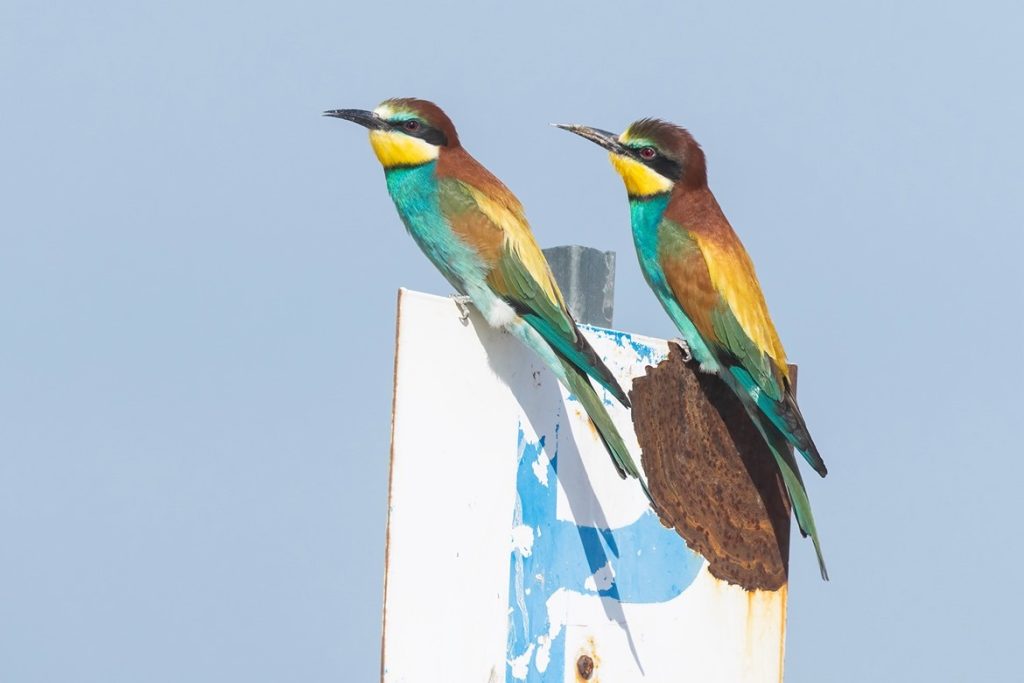
The European Bee-eater is one of the most colourful birds in Europe, and each observation during our tour was celebrated.
Detailed Report
Day 1, 12th April 2023. Arrival in Seville
The first day of our tour kicked off with the excitement of arrival. Mary and Gail breezed into Seville airport from Madrid mid-afternoon, and were warmly greeted by Javi, the Spanish guide from Birding Ecotours. From the airport, we made a beeline for our nearby hotel.
Eager to dive into the world of Spanish birdwatching, we wasted no time. After a swift check-in, we embarked on an easy one-hour stroll through the streets and gardens surrounding our hotel. Nature did not disappoint – rewarding us with sightings of both Common and Pallid Swift, House Martin and Barn Swallow. Luckily, we detected a fall of migrants in the urban gardens, treating us to sights of Woodchat Shrike, Western Subalpine Warbler, Melodious Warbler, and European Robin. Among the resident bird population, we spotted European Goldfinch, Greenfinch, Common Linnet, Common Blackbird, Sardinian Warbler, and Spotless Starling.
In the evening we enjoyed a welcome meal at the hotel, setting the stage for our thrilling itinerary which lay ahead.
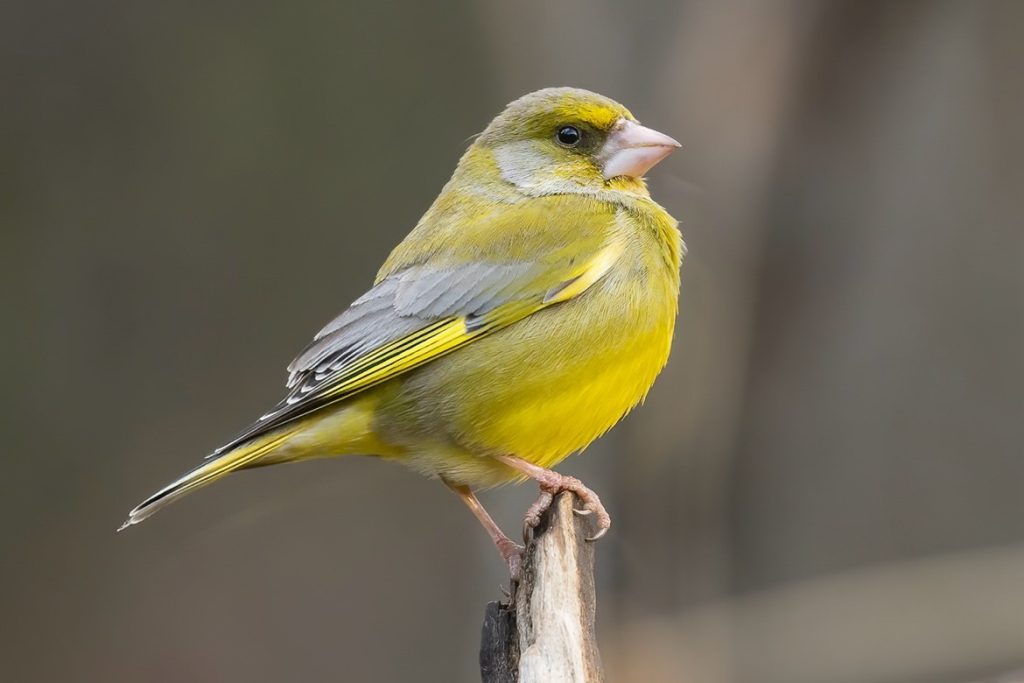
We were able to enjoy the brightly colored European Greenfinch during much of the tour.
Day 2, 13th April 2023. Birding Brazo del Este, Laguna Juncosa, Costa Ballena and Chipiona
Today, our first full day, we went south from Seville to the borderlands between the provinces of Seville and Cadiz. Our initial destination was Brazo del Este, a sprawling wetland and agricultural expanse adjacent to the mouth of the Guadalquivir River. This locale proved to be a remarkably fruitful birding haven, showcasing its richness, despite the severe drought conditions prevailing during our visit. During the morning, we were delighted to observe a total of 69 bird species, including Greater Flamingo, Western Swamphen, Pied Avocet, Black-tailed Godwit, Collared Pratincole (100+), Whiskered Tern, Purple Heron, and Glossy Ibis. Notably, the morning brought us our first encounter with the celebrated European Bee-eater. Adding to the excitement, the usually elusive Western Olivaceous Warbler offered splendid views as it sang loudly from the dense reed beds.
At noon, while enjoying our picnic lunch in an urban park in the neighboring town of Pinzón, we were excited to come across a European Pied Flycatcher.
During the afternoon, now in the province of Cádiz, we visited the Laguna Juncosa lagoon. Here a gorgeous flock, totaling over 100 Greater Flamingos, absorbed our attention when we arrived. Next, we began discovering an interesting array of species, including Red-crested Pochard, Ruff, Black-necked Grebe, Black-winged Stilt, Red Kite and a Red Fox too. In the riverside grove, we encountered three Eurasian Hoopoes and a splendid Iberian Green Woodpecker which, fortunately, remained motionless on a dry trunk, allowing detailed scope views. In fact, this bird unanimously became the bird of the day. Our next stop was at the Costa Ballena ponds, which produced yet another bird of the day, the iconic White-headed Duck, along with some interesting gulls such as Audouin´s Gull, Slender-billed Gull and Mediterranean Gull. Afterwards, we journeyed to the neighboring town of Chipiona, where our comfortable hotel awaited. However, before officially concluding our day, we couldn’t resist the temptation to visit the sole breeding colony on the entire European continent of Little Swift. Our efforts were handsomely rewarded with exceptional views of this typically African species bathed in the warm glow of a delightful late afternoon.
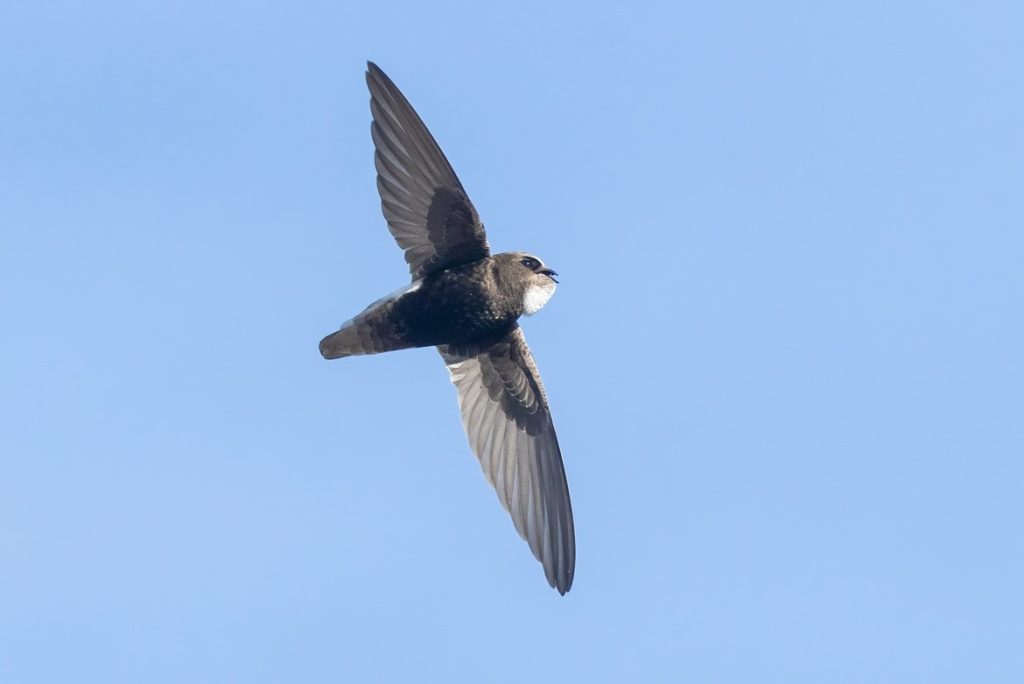
Little Swift, a recent colonizer of the European continent from Africa, was seen at Chipiona
Day 3, 14th April 2023. From the Guadalquivir mouth in Cádiz to Doñana National Park
Today we began with an early morning walk from the hotel, along the sea promenade of Chipiona. The sight of an adult Peregrine elegantly perched on a ledge of the lighthouse signaled the beginning of a fresh day of birdwatching. Next, we visited the beach at Playa de Montijo, which proved to be a festival of shorebirds (waders) with Kentish Plover, Sanderling, Grey Plover, Eurasian Oystercatcher, Rudy Turnstone, Eurasian Whimbrel, Green Sandpiper, Common Redshank, Common Greenshank, and many others. Also present were a good number of Little Tern, plus singles of Sandwich Tern and Osprey.
At midmorning we visited La Algaida Stone Pine Woodland, where Booted Eagle, Eurasian Spoonbill, White Stork and Grey Heron share the treetops, creating a vivid mixed colony, locally referred to as “pajareras”. We walked amongst the trees until we spotted a Western Bonelli’s Warbler. Not much further, at El Tarelo lagoon, we were fortunate to observe a Little Bittern. Additionally, we managed to find four more White-headed Duck and a group of Common Waxbill.
At noon we headed to the fantastic Salinas de Bonanza. Interesting species found here included Curlew Sandpiper, Little Stint, over a hundred stunning Slender-billed Gull, Caspian Tern, vast numbers of Greater Flamingo and one of the recently reclassified Mediterranean Short-toed Lark. Subsequently, we ventured to the unassuming Lagunas de Camino Colorado, affectionately known as the Stinky Pools. Our visit yielded excellent views of our primary target, Red-knobbed Coot, along with six additional White-headed Duck and seven Red-crested Pochard, amidst a diverse assortment of other waterbirds.
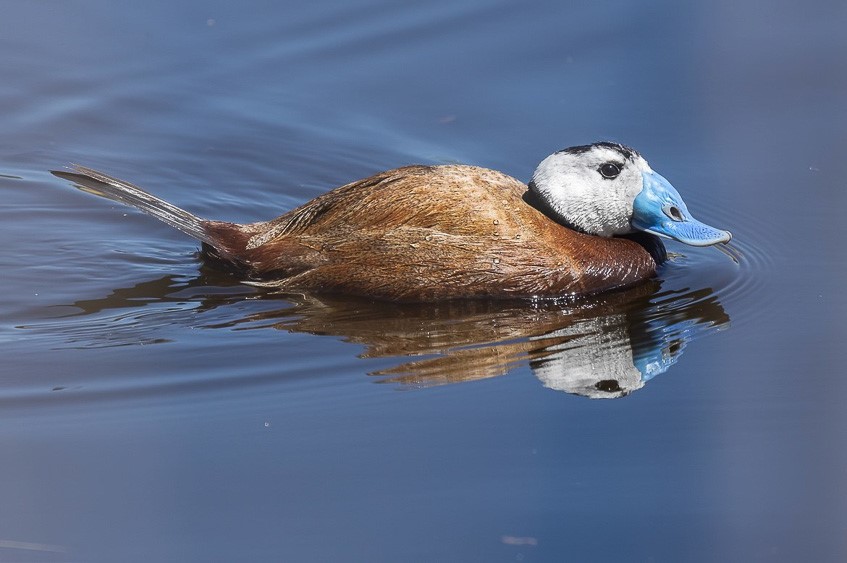
The third day of the tour turned out to be particularly successful when it came to observing White-headed Duck.
In the afternoon we crossed the Guadalquivir River, using the same small ferry utilized by traditional pilgrims during the Rocío pilgrimage. On the way to the hotel, we made a strategic stop to enjoy a colourful colony of European Bee-eater right on the roadside embankment.
After checking into the hotel and before dinner, at sunset, we visited the open woodland of Dehesa Tornero, in the core of Coto Doñana National Park. This area is well known as a stronghold of Iberian Lynx, but despite extensive searching we were not able to locate any of these extremely rare big cats. However, good birds were aplenty here. Indeed, we enjoyed our first Azure-winged Magpie of the trip. On the way back to the hotel, in complete darkness, the car’s headlights allowed us to enjoy a complete family of five Tawny Owl, the bird of the day!
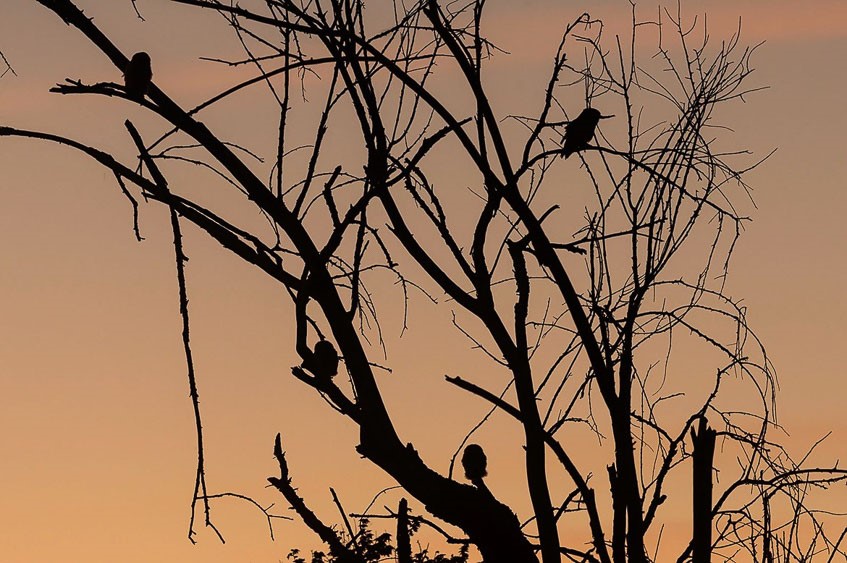
We enjoyed this family group of Tawny Owl with recently fledged offspring.
Day 4, 15th April 2023. El Rocío and Doñana National Park: La Rocina and El Acebrón
Today was entirely dedicated to birdwatching in the diverse habitats of Doñana National Park. Our day began with a dawn visit to Dehesa Tornero, where a Common Cuckoo and two Eurasian Hoopoe treated us to a delightful spectacle. After breakfast, we took a leisurely stroll around the hotel surroundings, spotting the first Eurasian Tree Sparrows of the trip and enjoying excellent views of Iberian Magpie.
Towards the end of the morning, we explored El Rocío and the adjacent “La Madre” Lagoon, the park’s most iconic location. Despite the low water levels, we observed a variety of birds, including Graylag Goose, Greater Flamingo, Eurasian Spoonbill, White Stork, Collared Pratincole, Eurasian Coot, and Common Shelduck. Notably, we were fortunate to spot a Temminck’s Stint, a scarce migrant in Spain.
In the afternoon, we ventured to the La Rocina area, where we had an outdoor picnic while observing Short-toed Treecreeper, Savi’s Warbler and many others. Not far from here, at El Acebrón riparian forest, we easily spotted a local highlight, the Iberian Chiffchaff, and we delighted in the melodious song of the nightingale.
In the early afternoon we returned to our comfortable hotel for a well-deserved rest.
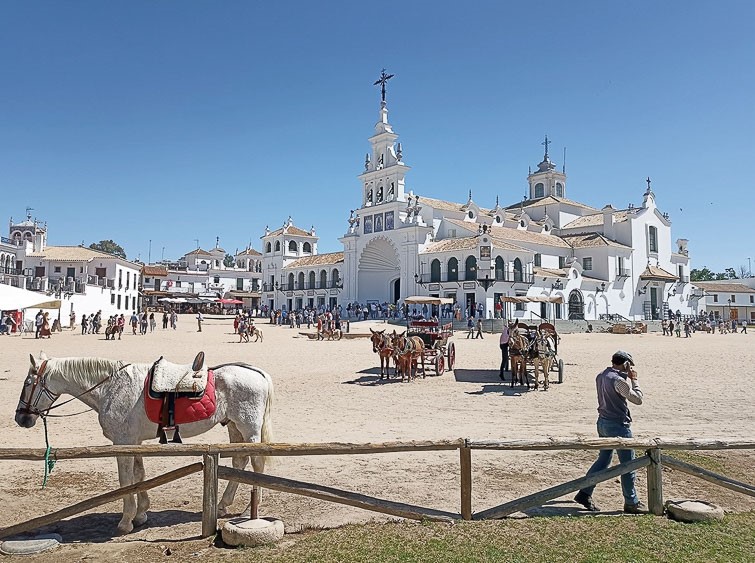
El Rocío is a picturesque village in the heart of Doñana National Park, characterized by its sandy streets and whitewashed houses that evoke a traditional Andalusian atmosphere.
Day 5, 16th April 2023. El Rocio to Extremadura
We started the day in a relaxed manner, before bidding farewell to Andalusia and heading north to Extremadura. At noon, we arrived at the Chozos de Llera, where we were greeted by two majestic immature Spanish Imperial Eagle!
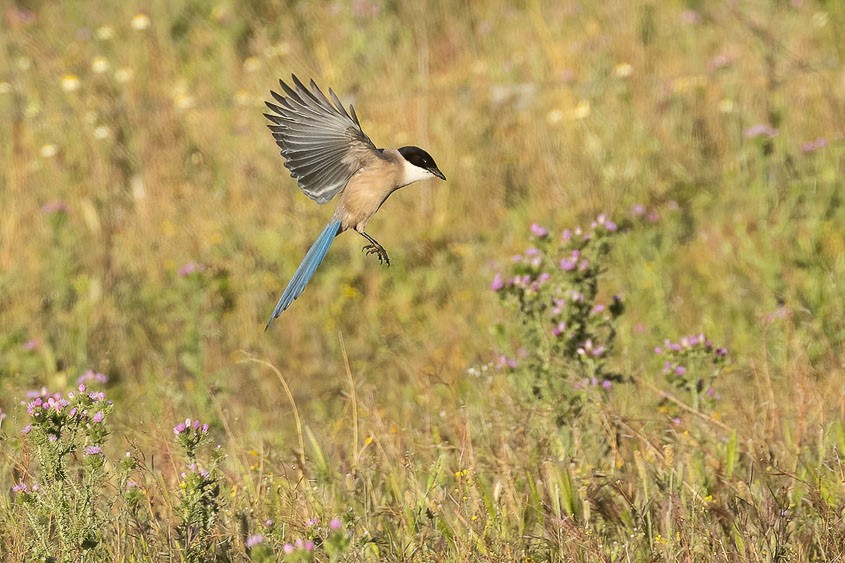
Iberian Magpie is one of the most sought-after species on any birding trip to Spain. We had great encounters with this iconic species while birding in Doñana National Park.
From a picnic table on a beautiful promontory, we also had the pleasure of enjoying the first (of many) Cinereous Vulture, while Thekla’s Lark displayed all round. Unfortunately, Gail began to experience stomach discomfort, so we set course for the hotel, with the memory of the iconic and endangered eagles in our minds.
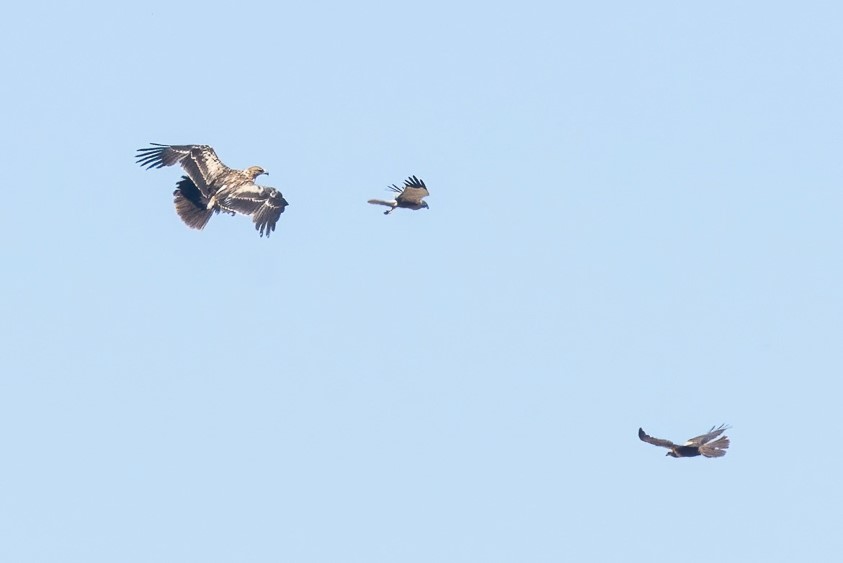
As European raptors go, it’s hard to find one more iconic than Spanish Imperial Eagle. Here is one of the two juveniles we saw together, being harassed by two Western Marsh Harriers.
Day 6, 17th April 2023. Monfragüe National Park and surrounds
Today we took the short journey into the beautiful Monfragüe National Park, with a first stop at the famous “Salto del Gitano”. As usual in this extraordinary area, the targets gradually appeared, providing excellent views, including Blue Rock Thrush, Black Redstart, Rock Bunting, Black Stork at their nests, and Cinereous, Egyptian and Griffon Vulture, these last ones seen in every possible way. Remarkably, despite the distance, we managed to see a pair of Bonelli’s Eagle on their nesting platform on a eucalyptus tree. Not much further, between Fuente del Frances and Las Corchuelas, we found the always impressive Alpine Swift, Short-toed Snake Eagle, Western Subalpine Warbler, Dartford Warbler and Western Black-eared Wheatear. Our outstanding sighting of a breeding pair of Lesser-spotted Woodpecker deserves special mention.
We finished the day visiting a breeding colony of Lesser Kestrel, beautifully placed at a Romanesque chapel in the town of Saucedilla.
We still had time to enjoy the beautiful surroundings of our hotel, where Eurasian Crag Martin, House Martin and Spanish Sparrow were fully engaged in their breeding activities.
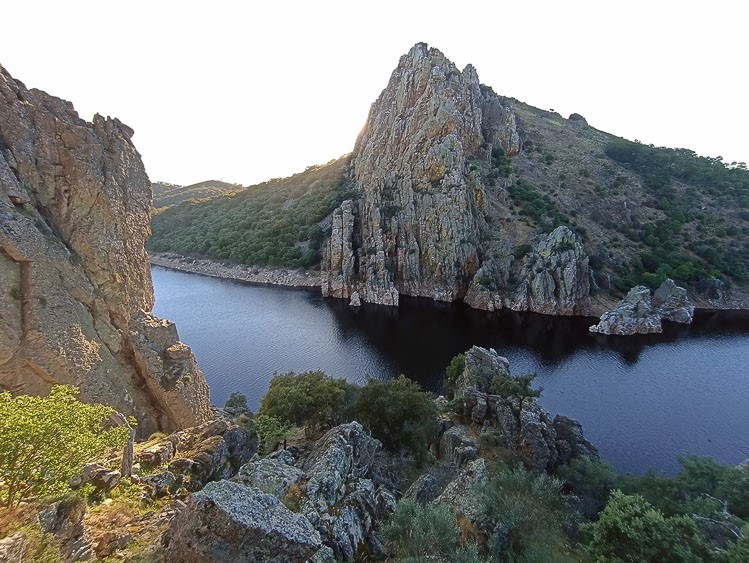
“El Salto del Gitano” stands as a prominent landmark in Monfragüe National Park and holds a large colony of Griffon Vultures and several pairs of Black Stork, all surrounded by a pristine “dehesas” and Mediterranean forest.
Day 7, 18th April 2023. Santa Marta Steppes, Trujillo and Gredos Mountains
Today, we woke early to reach the steppes of Santa Marta with the first light of day. Undoubtedly, this was a very wise decision, as we were able to observe at our leisure the elaborate courtship display of a male Great Bustard to a group of females.
We couldn’t believe our luck as we witnessed the so-called foam bath intricate performance of the male, capturing the attention of a group of females. This captivating display involved the majestic bird puffing up its feathers, gracefully raising and lowering its wings. All of this was enhanced, if possible, by the beautiful morning light. This turned out to be one of the most remarkable moments of the trip. As if this were not enough, just a few hundred feet ahead, another group of naturalists kindly directed us to a male Little Bustard, also in courtship! A great encounter with a Little Owl was another highly celebrated moment.
Our next stop was at the old town of Trujillo, hometown of Francisco Pizarro, the Spanish conquistador known for his exploration and conquests in South America during the early 16th century. Our reason for visiting the town was mainly to observe, at very close range, a Eurasian Scops Owl in its usual day roost in a beautiful horse chestnut tree in an urban park.
In the early afternoon, we hit the road again, to Gredos Mountains. At the roadside, we managed great views of a Greater Spotted Cuckoo and an immature Bonelli’s Eagle.
We received a warm welcome at Hotel Almanzor from our friends, Luis Alfonso and Loli. Once settled into our cosy rooms, we had an opportunity to enjoy an initial visit to the excellent bird feeder and hide, right at the hotel.
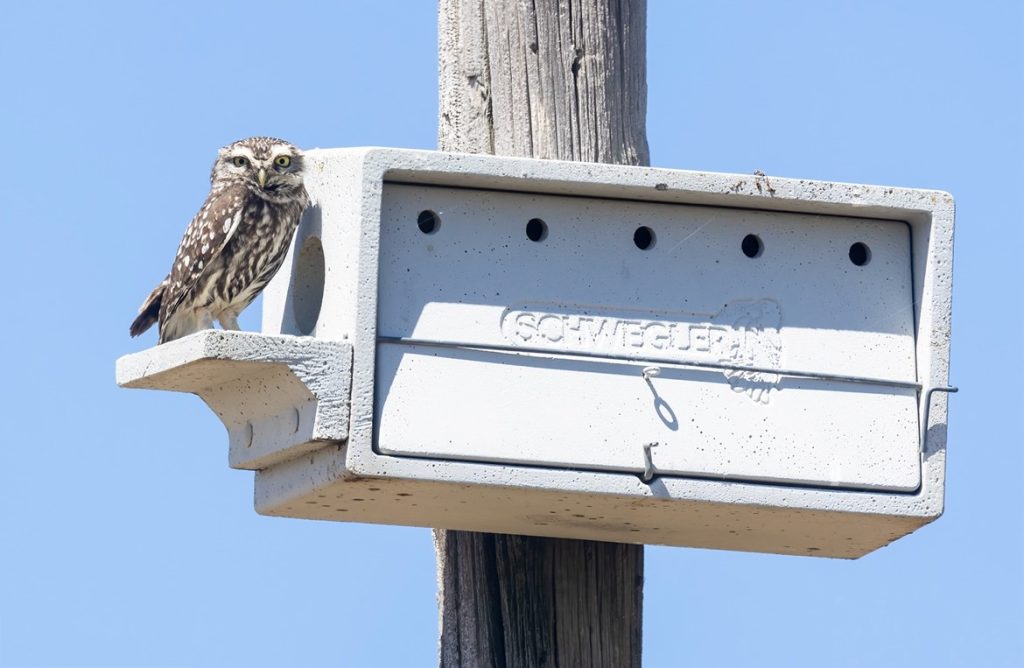
During the tour, we particularly enjoyed the owls, such as this Little Owl in its nest box in the Plains of Caceres, Extremadura.
Day 8, 19th April 2023. Sierra Gredos: Plataforma de Gredos and Pine Woodland
Today was spent exploring the beautiful Sierra Gredos. Before heading out, we searched the area around our hotel, including the excellent bird feeder. This gave us unbeatable views of a striking Greater Spotted Woodpecker, Eurasian Nuthatch, Eurasian Wren, European Robin and Rock Sparrow.
During our exploration of the stunning La Plataforma high mountain area, we saw Booted Eagle, Woodlark, Common Whitethroat, Northern Wheatear and Water Pipit. However, the most remarkable sightings were Ortolan Bunting, two Common (Rufous-tailed) Rock Thrush and plenty of Dunnock (the mabbotti subspecies, a recently touted potential split as “Iberian Dunnock”).
The close encounters with numerous Spanish Ibex, some with impressive antlers, also provided immense enjoyment and great photographic opportunities.
Finally, we explored the pine forests at lower altitudes, where we enjoyed good views of White-throated Dipper, Crested Tit, Citril Finch and Common Firecrest, Goldcrest, Coal Tit and Red Crossbill, to name but a few. In part, all of this happened while we remained comfortably seated on two chairs by a beautiful clearing in the forest. With all the day’s goals more than achieved, we decided to return to the hotel, with plenty of time to enjoy another session at the bird feeders.
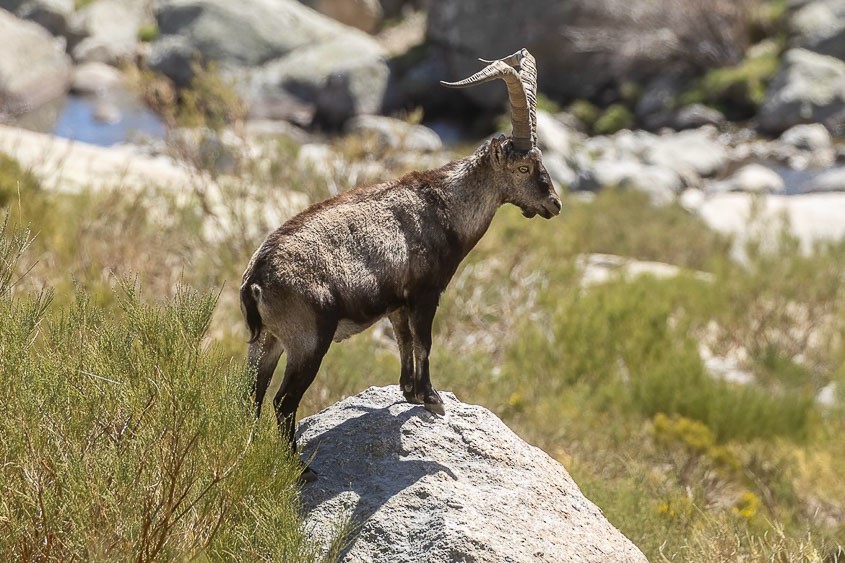
The Spanish Ibex stands as one of Spain’s most iconic mammals, exemplified by this spectacular male in full display, for the delight of the group.
Day 9, 20th April 2022. From Gredos to Pamplona: Steppes of Ablitas and Pitillas Lagoon
Before bidding farewell to the Gredos mountains, we woke up early to search for our last major objective in the area, the Bluethroat, in its pristine mountain breeding grounds. Fortunately, we managed to see two specimens, one of them particularly well.
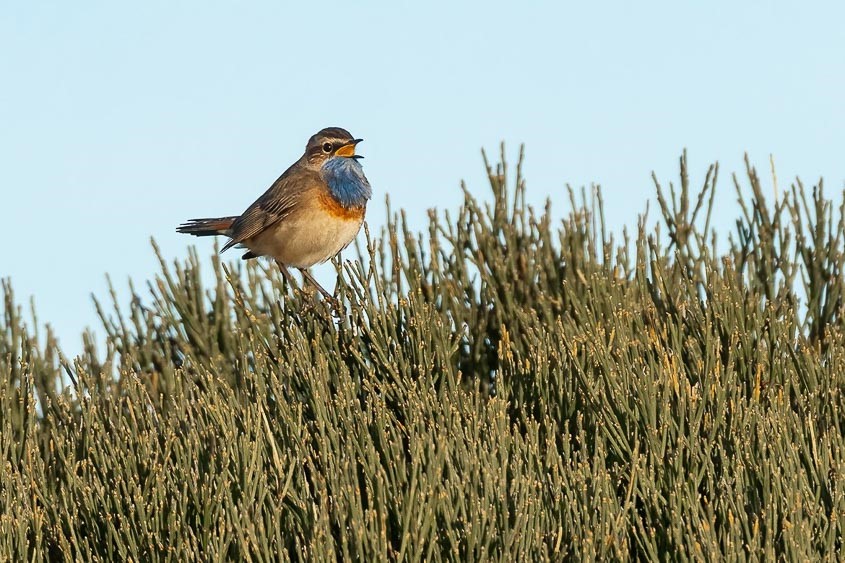
To get a good look at the mythical Bluethroat we had to wake up early and engage in a pre-breakfast birding session in the high plateaus of Gredos Mountains in central Spain.
Next, we returned to our hotel for breakfast and to say our goodbyes. Then we headed north, on a rather long journey to the steppes of Ablitas in Navarra. Upon arrival, we enjoyed an excellent sighting of perched European Bee-eater. With great effort and perseverance, we managed to find one of the most challenging objectives of the trip and Iberian birdlife, Dupont’s Lark. As is usual with this elusive species, initially we only managed to hear its plaintive call. Happily, and without prior notice, an adult, followed by a chick, appeared just a few feet from our car, allowing us to enjoy their presence at our leisure. It was a dreamlike observation!
Our next destination was Pitillas Lagoon, which proved to be quieter than usual for this time of year. Nevertheless, we saw Mute Swan, Tufted Duck, Eurasian Skylark, and a group of baby Wild Boar on our path. We then drove to our hotel in downtown Pamplona, a city globally renowned for the running of the bulls.
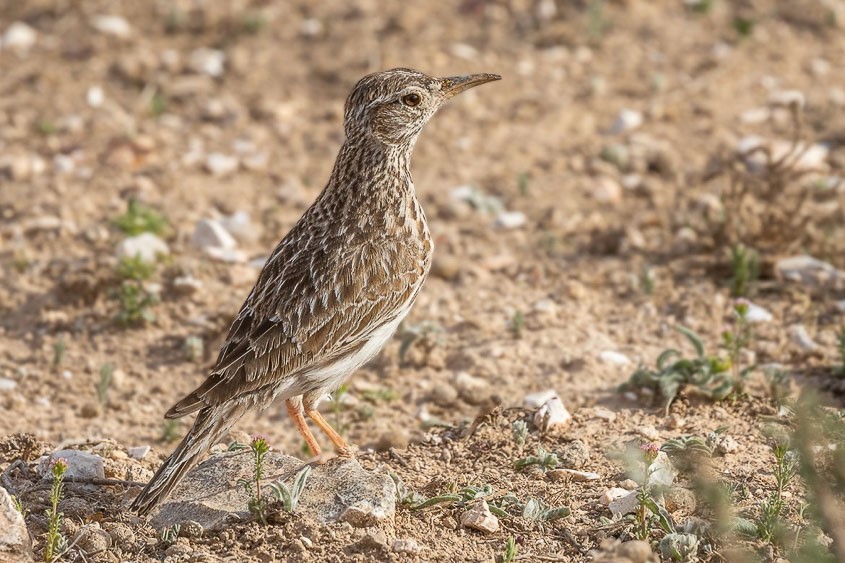
This striking Dupont´s Lark showed up exceptionally well, accompanied by a recently fledged chick.
Day 10, 21st April 2023. From Pamplona to the Western Pyrenees
Firstly, we visited Quinto Real, a transboundary (with France) forest area, a deciduous forest composed primarily of beeches, chestnuts, oaks, and alders. This is a purely Atlantic environment, markedly different from the Mediterranean setting of the first half of the tour. We took a gentle and leisurely walk, paying attention to every song and movement in the treetops, and found Eurasian Jay, Crested Tit, Coal Tit, Great Tit, and we detected the first Song Thrush and Eurasian Treecreeper of the trip.
Next, we visited some high mountain passes, but the bothersome wind made us give up and continue our route towards the east. We had our picnic in the stunning Foz de Arbayún, the gateway to the Pyrenees. Here we saw our first distant Bearded Vulture soaring high over the deep gorge. These were sharing the sky with a group of Alpine Swifts and two Egyptian Vultures.
In the afternoon, we crossed the Pyrenean valley of Larra and Belagua. Here, the most notable observations were the elegant Chamois. We ended the day enjoying a craft beer next to the fireplace at our hotel, located in an idyllic setting in the mountains of the Hecho Valley.
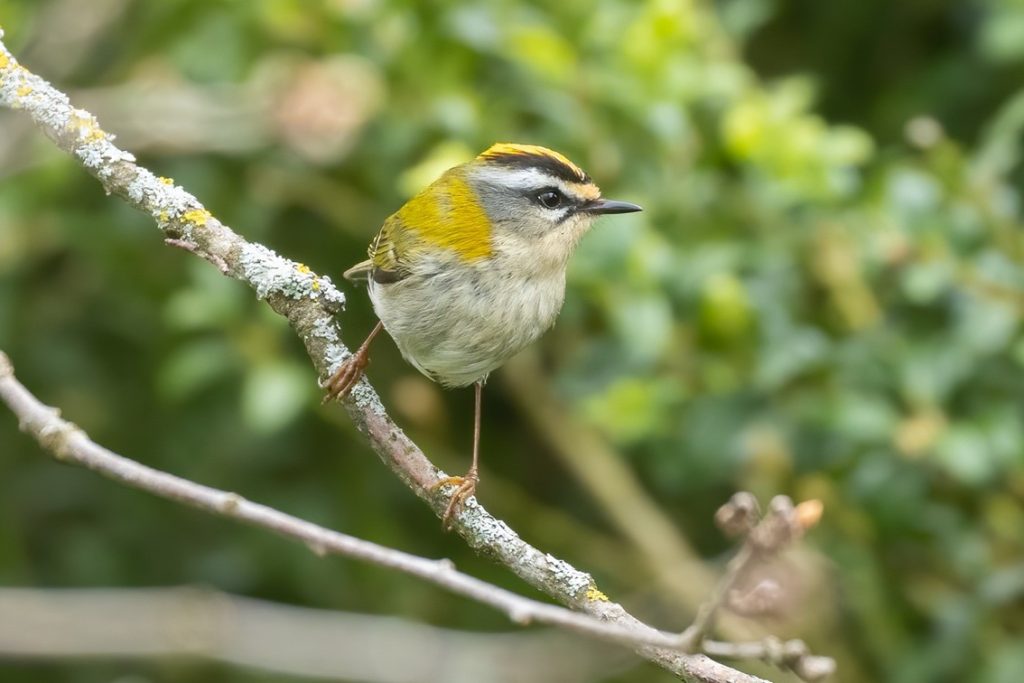
This obliging Common Firecrest enlivened our picnic lunch in the woods.
Day 11, 22nd April 2023. Pyrenees between Aragón and Navarra.
The day dawned partially cloudy with showers. We started the day by visiting the surroundings of the Refugio de Gabardito shelter. Unfortunately, the rain prevented us from completing the route through a limestone massif, a prime area for observing Wallcreeper. In turn, we had no less than seven (!) Egyptian Vulture perched on the ground in a farm, several Roe Deer and wonderful views of Mistle Thrush. At this point, we made a short detour to get some medicine.
We spent the rest of the day visiting the most attractive locations in the adjacent valleys between Aragon and Navarra. A remarkable sight was a pair of Golden Eagle gliding over the head of a glacial cirque and perched on the snow. In the same area, a large mixed flock of hundreds of Red-billed and Alpine Choughs showed up.
We also saw Bearded Vulture, Yellowhammer and White-throated Dipper. We were driving, and had almost lost hope of finding it, when an unexpected Black Woodpecker appeared briefly, perched at the base of a trunk on the roadside!
As a result of the storms, we found the road in one of the valleys blocked due to the overflowing of a river with red ferruginous waters, creating a beautiful scene.
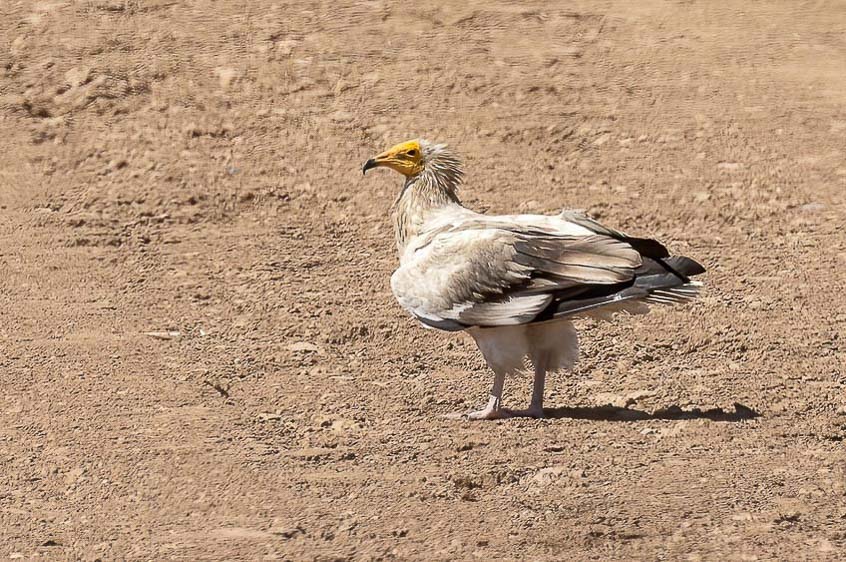
We found this splendid adult Egyptian Vulture on the roadside in northern Spain.
Day 12, 23rd April 2023. From Hecho to Ordesa y Monte Perdido National Park with a brief foray into France
Dawn was rainy and we made a final, unsuccessful, attempt to locate the elusive wallcreeper in a gorge very close to our hotel. Seeing that the weather wasn’t improving, we decided to descend to lower altitudes and set course for our next destination in the Central Pyrenees. Along the way, we had multiple encounters with Red Kite, one of the best-represented raptors of the trip.
At noon, we visited the beautiful surroundings of San Juan de la Peña, including a territory of the Black Woodpecker, which unfortunately did not makean appearance.
We enjoyed watching Griffon Vultures in their nests perched on impressive cliffs.
We made a brief detour into France to visit Le Portalet area, to enjoy the impressive mountain landscapes. We then spent the rest of the day getting to our hotel in the Central Pyrenees.
Day 13, 24th April 2023. Torla and Ordesa National Park
Today was planned to be one of the most special of the tour. On the one hand, we had the extra assistance of Juan Carlos, a professional biologist and one of the most experienced ornithologists in the area. On the other hand, due to the unusual lack of snow at the higher altitudes of the park, we had the rare opportunity to access the high meadows in April, something truly uncommon. To do this, we used a private vehicle expressly authorized to travel on a restricted track and access Cuello Gordo area. Next, we hiked a couple of miles on a rather challenging path, to reach an extremely impressive viewpoint overlooking the main canyon in Ordesa National Park. In doing so, we saw Marmot, Water Pipit, Northern Wheatear, Eurasian Skylark, Red-billed and Alpine Choughs, plenty of Griffon and a Bearded Vulture. Unfortunately, probably also due to the lack of snow, we didn’t manage to find other typical species, such as the Wallcreeper. Fortunately, we did get great views of an Alpine Accentor.
During the afternoon, still in the company of Juan Carlos, we visited several key locations in the lower area of the national park. Firstly, we visited a Bearded Vulture breeding area. While we waited and enjoyed a picnic, we spotted an adult bird in the far distance. Fortunately, the bird visited its nest, flying over the area where we were located. In the same area, we also saw a Golden Eagle.
To finish the birding journey, we explored several forest areas where we had a very good view of a Marsh Tit and a Eurasian Treecreeper. While driving back to Torla, a male Eurasian Bullfinch crossed the road in front of us.
We then left the high Pyrenees, with the most dramatic landscapes of the journey, to continue east towards our next destination in Lleida, Catalonia.
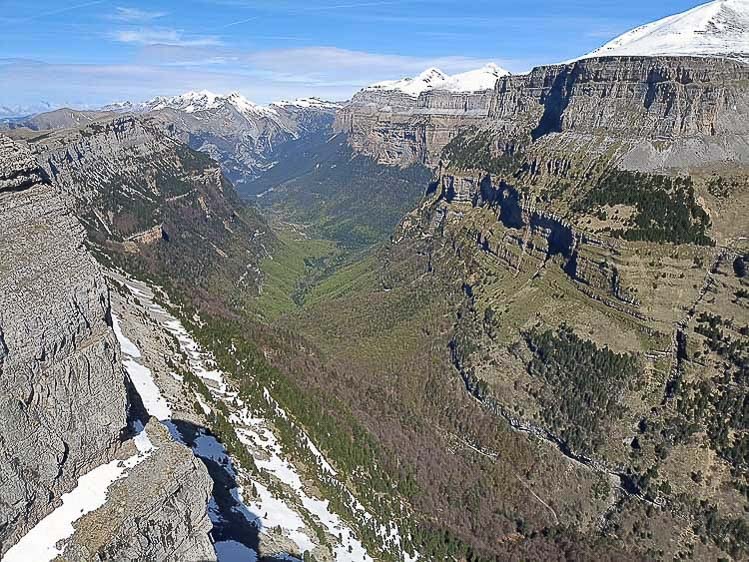
The glacial valley of Ordesa National Park, in the central Pyrenees, is the realm of the Wallcreeper and one of the most spectacular landscapes in Spain.
Day 14, 25th April 2023. Outskirts of Lleida
Today we were accompanied by Jose, a local expert on birding in the Lleida area. Jose’s deep knowledge of his local area proved invaluable, and thanks to him we enjoyed a very varied array of species. In fact, as soon as we arrived at the first birdwatching area, we could clearly hear the distinctive song of Dupont’s Lark. It’s worth noting how unusual it is to detect this threatened and elusive species in two different populations on the same tour.
Other remarkable sightings included Red-crested Pochard, Red-legged Partridge, Whinchat, Short-toed Snake Eagle, Montagu’s Harrier, European Turtle Dove, and Stock Dove. The remarkable observations of Pin-tailed Sandgrouse, Little Bustard, Great Spotted Cuckoo, Eurasian Stone-curlew and Black Wheatear stood out!
As if this were not enough, Jose still had many surprises in store for us and took us to his secret spots to enjoy a Long-eared Owl and a family of four Eurasian Eagle-Owls! We also had time to visit a colony of Lesser Kestrel and Red-billed Chough in an old building.
As a final touch, before returning to the hotel, Jose took us to our last great objective, Eurasian Hobby. We then said a warm goodbye to Jose and thanked him for his friendliness and for providing us with one of the most fruitful birding days of the trip.
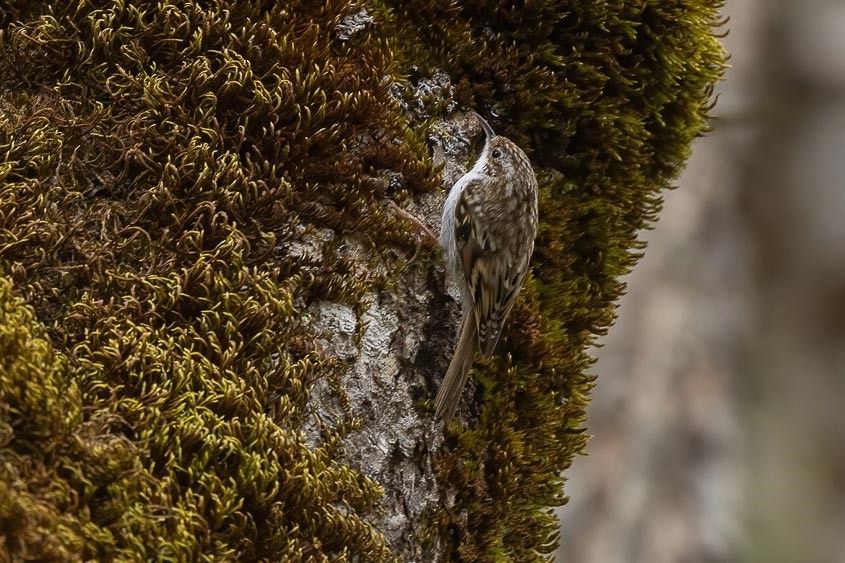
Obtaining convincing views of the Eurasian Treecreeper required a considerable effort, but it was undoubtedly worth it.
Day 15, 26th April 2023. Lleida to Barcelona: Delta del Llobregat
This was to be our last full day of birdwatching, and we still had many possible targets, so we decided to wake up early to make the most of it. This way, we arrived at the Utxesa reservoir at dawn and rather easily managed to find two Common Kingfisher, three Eurasian Penduline Tit, about six Bearded Reedling, three Great Reed Warbler and two Moustached Warbler. However, the most unexpected thing was hearing a Common Grasshopper Warbler.
In another nearby wetland, on our way to Barcelona, we added Great Crested Grebe and Northern Lapwing to the trip list.
We arrived at our magnificent hotel in Barcelona in the early afternoon. We had time to settle in and rest briefly before heading out for our last birding session at the famous Delta del Llobregat, a wetland area near Barcelona airport. From the comfort of well-designed wooden observatories, we managed to enjoy a wide variety of waterfowl species, such as Northern Pintail, Greater Flamingo, Western Swamphen, Black-winged Stilt, Common Snipe, Ruff, and Curlew Sandpiper. Walking among the observatories, we also found some interesting migrants including Garden Warbler, Common Redstart, Willow Warbler, and Sand Martin.
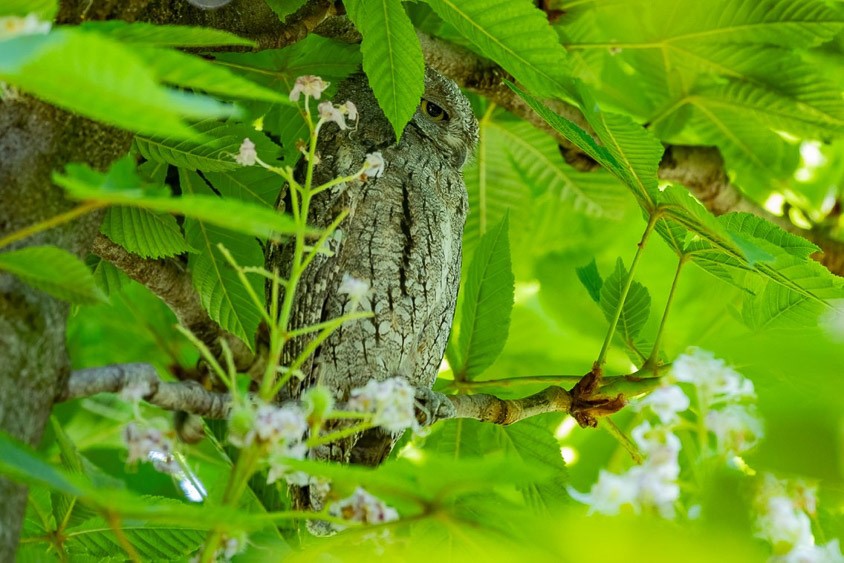
Finding this Eurasian Scops Owl day-roosting in the dense foliage was not an easy task.
Our final stop of the day, and the tour, was on a beach near the hotel, from where we carried out a short sea-watching session. Despite the considerable distance to the birds, we managed to conclude the tour with two species of great interest, Cory’s Shearwater and the Critically Endangered Balearic Shearwater.
After another productive day, we headed to our hotel for the final meal and discussed the ‘Bird of the Trip’. After careful consideration, we chose the courtship display of the Great Bustards in Extremadura. Undoubtedly, a very fair and wise decision!
Day 16, 27th April 2023. Tour conclusion in Barcelona
On the very last day of the tour, we rose early to arrive at the airport at first light, a task we executed rapidly and uneventfully. There, Javi bid farewell to Mary and Gail, and each of us proceeded homeward, our minds still brimming with the beautiful scenes of the birdlife in Spain.
Bird List – Following IOC (12.1)
Birds ‘heard only’ are marked with (H) after the common name, all other species were seen.
| Common Name | Scientific Name |
| Anatidae – Ducks and Geese | |
| Graylag Goose | Anser anser |
| Mute Swan | Cygnus olor |
| Egyptian Goose | Alopochen aegyptiaca |
| Common Shelduck | Tadorna tadorna |
| Northern Shoveler | Spatula clypeata |
| Gadwall | Mareca strepera |
| Mallard | Anas platyrhynchos |
| Northern Pintail | Anas acuta |
| Marbled Teal | Marmaronetta angustirostris |
| Red-crested Pochard | Netta rufina |
| Common Pochard | Aythya ferina |
| Tufted Duck | Aythya fuligula |
| White-headed Duck | Oxyura leucocephala |
| Phasianidae – Quails and Partridges | |
| Common Quail (H) | Coturnix coturnix |
| Red-legged Partridge | Alectoris rufa |
| Podicipedidae – Grebes | |
| Little Grebe | Tachybaptus ruficollis |
| Horned Grebe | Podiceps auritus |
| Great Crested Grebe | Podiceps cristatus |
| Phoenicopteridae – Flamingoes | |
| Greater Flamingo | Phoenicopterus roseus |
| Procellariidae – Shearwaters and Petrels | |
| Cory’s Shearwater | Calonectris borealis |
| Balearic Shearwater | Puffinus mauretanicus |
| Ciconiidae – Storks | |
| Black Stork | Ciconia nigra |
| White Stork | Ciconia ciconia |
| Phalacrocoracidae – Cormorants | |
| Great Cormorant | Phalacrocorax carbo |
| Ardeidae – Herons and Egrets | |
| Little Bittern | Ixobrychus minutus |
| Grey Heron | Ardea cinerea |
| Purple Heron | Ardea purpurea |
| Great Egret | Ardea alba |
| Little Egret | Egretta garzetta |
| Western Cattle Egret | Bubulcus ibis |
| Squacco Heron | Ardeola ralloides |
| Black-crowned Night Heron | Nycticorax nycticorax |
| Threskiornithidae – Ibises and Spoonbills | |
| Glossy Ibis | Plegadis falcinellus |
| Eurasian Spoonbill | Platalea leucorodia |
| Pandionidae – Ospreys | |
| Osprey | Pandion haliaetus |
| Accipitridae – Vultures, Eagles and Kites | |
| Bearded Vulture | Gypaetus barbatus |
| Egyptian Vulture | Neophron percnopterus |
| Cinereous Vulture | Aegypius monachus |
| Eurasian Griffon | Gyps fulvus |
| Short-toed Snake Eagle | Circaetus gallicus |
| Booted Eagle | Hieraaetus pennatus |
| Spanish Imperial Eagle | Aquila adalberti |
| Golden Eagle | Aquila chrysaetos |
| Bonelli’s Eagle | Aquila fasciata |
| Western Marsh Harrier | Circus aeruginosus |
| Montagu’s Harrier | Circus pygargus |
| Northern Goshawk (H) | Accipiter gentilis |
| Red Kite | Milvus milvus |
| Black Kite | Milvus migrans |
| Common Buzzard | Buteo buteo |
| Otididae – Bustards | |
| Great Bustard | Otis tarda |
| Little Bustard | Tetrax tetrax |
| Rallidae – Crakes and Moorhens | |
| Water Rail (H) | Rallus aquaticus |
| Western Swamphen | Porphyrio porphyrio |
| Eurasian Moorhen | Gallinula chloropus |
| Red-knobbed Coot | Fulica cristata |
| Eurasian Coot | Fulica atra |
| Burhinidae – Thick-knees | |
| Eurasian Stone-curlew | Burhinus oedicnemus |
| Recurvirostridae – Stilts and Avocets | |
| Black-winged Stilt | Himantopus himantopus |
| Pied Avocet | Recurvirostra avosetta |
| Haematopodidae – Oystercatchers | |
| Eurasian Oystercatcher | Haematopus ostralegus |
| Charadriidae – Plovers and Lapwings | |
| Grey Plover | Pluvialis squatarola |
| Northern Lapwing | Vanellus vanellus |
| Kentish Plover | Charadrius alexandrinus |
| Common Ringed Plover | Charadrius hiaticula |
| Little Ringed Plover | Charadrius dubius |
| Scolopacidae – Sandpipers and Godwits | |
| Eurasian Whimbrel | Numenius phaeopus |
| Eurasian Curlew | Numenius arquata |
| Bar-tailed Godwit | Limosa lapponica |
| Black-tailed Godwit | Limosa limosa |
| Ruddy Turnstone | Arenaria interpres |
| Ruff | Calidris pugnax |
| Curlew Sandpiper | Calidris ferruginea |
| Temminck’s Stint | Calidris temminckii |
| Sanderling | Calidris alba |
| Dunlin | Calidris alpina |
| Common Snipe | Gallinago gallinago |
| Common Sandpiper | Actitis hypoleucos |
| Green Sandpiper | Tringa ochropus |
| Spotted Redshank | Tringa erythropus |
| Common Greenshank | Tringa nebularia |
| Wood Sandpiper | Tringa glareola |
| Common Redshank | Tringa totanus |
| Glareolidae – Coursers and Pratincoles | |
| Collared Pratincole | Glareola pratincola |
| Laridae – Gulls and Terns | |
| Slender-billed Gull | Chroicocephalus genei |
| Black-headed Gull | Chroicocephalus ridibundus |
| Mediterranean Gull | Ichthyaetus melanocephalus |
| Audouin’s Gull | Ichthyaetus audouinii |
| Yellow-legged Gull | Larus michahellis |
| Lesser Black-backed Gull | Larus fuscus |
| Little Tern | Sternula albifrons |
| Gull-billed Tern | Gelochelidon nilotica |
| Caspian Tern | Hydroprogne caspia |
| Whiskered Tern | Chlidonias hybrida |
| Sandwich Tern | Thalasseus sandvicensis |
| Pteroclidae – Sandgrouses | |
| Pin-tailed Sandgrouse | Pterocles alchata |
| Columbidae – Pigeons and Doves | |
| Rock Dove (Feral Pigeon) | Columba livia |
| Stock Dove | Columba oenas |
| Common Wood Pigeon | Columba palumbus |
| European Turtle Dove | Streptopelia turtur |
| Eurasian Collared Dove | Streptopelia decaocto |
| Cuculidae – Cuckoos | |
| Great Spotted Cuckoo | Clamator glandarius |
| Common Cuckoo | Cuculus canorus |
| Strigidae – Owls | |
| European Scops Owl | Otus scops |
| Eurasian Eagle-Owl | Bubo bubo |
| Little Owl | Athene noctua |
| Tawny Owl | Strix aluco |
| Long-eared Owl | Asio otus |
| Apodidae – Swifts | |
| Alpine Swift | Apus melba |
| Common Swift | Apus apus |
| Pallid Swift | Apus pallidus |
| Little Swift | Apus affinis |
| Upudidae – Hoopoes | |
| Eurasian Hoopoe | Upupa epops |
| Alcedinidae – Kingfishers | |
| Common Kingfisher | Alcedo atthis |
| Meropidae – Bee-eaters | |
| European Bee-eater | Merops apiaster |
| Coraciidae – Rollers | |
| European Roller | Coracias garrulus |
| Picidae – Woodpeckers | |
| Eurasian Wryneck | Jynx torquilla |
| Lesser Spotted Woodpecker | Dendrocopos minor |
| Great Spotted Woodpecker | Dendrocopos major |
| Black Woodpecker | Dryocopus martius |
| Iberian Green Woodpecker | Picus sharpei |
| Falconidae – Falcons | |
| Lesser Kestrel | Falco naumanni |
| Eurasian Kestrel | Falco tinnunculus |
| Eurasian Hobby | Falco subbuteo |
| Peregrine Falcon | Falco peregrinus |
| Psittaculidae – Parrots and Lovebirds | |
| Rose-ringed Parakeet | Psittacula krameri |
| Psittacidae – New World and African Parrots | |
| Monk Parakeet | Myiopsitta monachus |
| Laniidae – Shrikes | |
| Iberian Grey Shrike | Lanius meridionalis |
| Woodchat Shrike | Lanius senator |
| Oriolidae – Orioles | |
| Eurasian Golden Oriole (H) | Oriolus oriolus |
| Corvidae – Corvids | |
| Eurasian Jay | Garrulus glandarius |
| Iberian Magpie | Cyanopica cooki |
| Eurasian Magpie | Pica pica |
| Red-billed Chough | Pyrrhocorax pyrrhocorax |
| Yellow-billed Chough | Pyrrhocorax graculus |
| Eurasian Jackdaw | Corvus monedula |
| Carrion Crow | Corvus corone |
| Common Raven | Corvus corax |
| Panuridae – Bearded reedling | |
| Bearded Reedling | Panurus biarmicus |
| Alaudidae – Larks | |
| Greater Short-toed Lark | Calandrella brachydactyla |
| Calandra Lark | Melanocorypha calandra |
| Dupont’s Lark | Chersophilus duponti |
| Mediterranean Short-toed Lark | Alaudala rufescens |
| Woodlark | Lullula arborea |
| Eurasian Skylark | Alauda arvensis |
| Thekla’s Lark | Galerida theklae |
| Crested Lark | Galerida cristata |
| Hirundinidae – Swallows and Martins | |
| Sand Martin | Riparia riparia |
| Eurasian Crag Martin | Ptyonoprogne rupestris |
| Barn Swallow | Hirundo rustica |
| Red-rumped Swallow | Cecropis daurica |
| Common House Martin | Delichon urbicum |
| Paridae, Remizidae, Aegithalidae – Tits | |
| Coal Tit | Periparus ater |
| Crested Tit | Lophophanes cristatus |
| Marsh Tit | Poecile palustris |
| Eurasian Blue Tit | Cyanistes caeruleus |
| Great Tit | Parus major |
| Remizidae – Penduline Tits | |
| Eurasian Penduline Tit | Remiz pendulinus |
| Aegithalidae – Long-tailed Tits | |
| Long-tailed Tit | Aegithalos caudatus |
| Sittidae – Nuthatches | |
| Eurasian Nuthatch | Sitta europaea |
| Certhiidae – Treecreepers | |
| Eurasian Treecreeper | Certhia familiaris |
| Short-toed Treecreeper | Certhia brachydactyla |
| Troglodytidae – Wrens | |
| Eurasian Wren | Troglodytes troglodytes |
| Cinclidae – Dippers | |
| White-throated Dipper | Cinclus cinclus |
| Regulidae – Kinglets | |
| Goldcrest | Regulus regulus |
| Firecrest | Regulus ignicapilla |
| Cettiidae – Cettiid Warblers | |
| Cetti’s Warbler | Cettia cetti |
| Phylloscopidae – Leaf Warblers | |
| Willow Warbler | Phylloscopus trochilus |
| Common Chiffchaff | Phylloscopus collybita |
| Iberian Chiffchaff | Phylloscopus ibericus |
| Western Bonelli’s Warbler | Phylloscopus bonelli |
| Acrocephalidae – Reed Warblers | |
| Western Olivaceous Warbler | Iduna opaca |
| Melodious Warbler | Hippolais polyglotta |
| Moustached Warbler | Acrocephalus melanopogon |
| Eurasian Reed Warbler | Acrocephalus scirpaceus |
| Great Reed Warbler | Acrocephalus arundinaceus |
| Locustellidae – Grass Warblers | |
| Savi’s Warbler | Locustella luscinioides |
| Common Grasshopper Warbler | Locustella naevia |
| Cisticolidae – Cisticolas | |
| Zitting Cisticola | Cisticola juncidis |
| Sylviidae – Sylvia Warblers | |
| Eurasian Blackcap | Sylvia atricapilla |
| Garden Warbler | Sylvia borin |
| Western Subalpine Warbler | Sylvia iberiae |
| Sardinian Warbler | Sylvia melanocephala |
| Greater Whitethroat | Sylvia communis |
| Dartford Warbler | Sylvia undata |
| Muscicapidae – Flycatchers | |
| European Robin | Erithacus rubecula |
| Common Nightingale | Luscinia megarhynchos |
| Bluethroat | Luscinia svecica |
| European Pied Flycatcher | Ficedula hypoleuca |
| Common Redstart | Phoenicurus phoenicurus |
| Black Redstart | Phoenicurus ochruros |
| Common Rock Thrush | Monticola saxatilis |
| Blue Rock Thrush | Monticola solitarius |
| Whinchat | Saxicola rubetra |
| European Stonechat | Saxicola rubicola |
| Black Wheatear | Oenanthe leucura |
| Northern Wheatear | Oenanthe oenanthe |
| Western Black-eared Wheatear | Oenanthe hispanica |
| Turdidae – Thrushes | |
| Common Blackbird | Turdus merula |
| Song Thrush | Turdus philomelos |
| Mistle Thrush | Turdus viscivorus |
| Sturnidae – Starlings | |
| Common Starling | Sturnus vulgaris |
| Spotless Starling | Sturnus unicolor |
| Prunellidae – Accentors | |
| Alpine Accentor | Prunella collaris |
| Dunnock | Prunella modularis |
| Motacillidae – Pipits and Wagtails | |
| Western Yellow Wagtail | Motacilla flava |
| White Wagtail | Motacilla alba |
| Grey Wagtail | Motacilla cinerea |
| Tawny Pipit | Anthus campestris |
| Tree Pipit | Anthus trivialis |
| Water Pipit | Anthus spinoletta |
| Emberizidae – Buntings | |
| Yellowhammer | Emberiza citrinella |
| Cirl Bunting | Emberiza cirlus |
| Rock Bunting | Emberiza cia |
| Ortolan Bunting | Emberiza hortulana |
| Corn Bunting | Emberiza calandra |
| Fringillidae – Finches | |
| Common Chaffinch | Fringilla coelebs |
| Eurasian Bullfinch | Pyrrhula pyrrhula |
| European Greenfinch | Chloris chloris |
| Eurasian Linnet | Linaria cannabina |
| Red Crossbill | Loxia curvirostra |
| European Goldfinch | Carduelis carduelis |
| Citril Finch | Carduelis citrinella |
| European Serin | Serinus serinus |
| Passeridae – Sparrows | |
| House Sparrow | Passer domesticus |
| Spanish Sparrow | Passer hispaniolensis |
| Eurasian Tree Sparrow | Passer montanus |
| Rock Petronia | Petronia petronia |
| Ploceidae – Weavers | |
| Black-headed Weaver | Ploceus melanocephalus |
| Estrildidae – Estrildid Finches | |
| Common Waxbill | Estrilda astrild |
| Total seen | 225 |
| Total heard only | 4 |
| Total recorded | 229 |
Mammal List
| Common Name | Scientific Name |
| Dogs (Canidae) | |
| Red Fox | Vulpes vulpes |
| Rabbits and Hares (Leporidae) | |
| European Rabbit | Oryctolagus cuniculus |
| Deer (Cervidae) | |
| (Spanish) Red Deer | Cervus elaphus hispanicus |
| Roe Deer | Capreolus capreolus |
| Bovids (Bovidae) | |
| Iberian Ibex (Gredos) | Capra pyrenaica victoriae |
| Chamois | Rupicapra rupicapra |
| Pigs and hogs (Suyidae) | |
| Wild Boar | Sus scrofa |
| Squirrels (Sciuridae) | |
| Marmot | Marmota marmota |
| Total seen | 8 |
DOWNLOAD TRIP REPORT
Please see the downloadable PDF above with the full species lists included. This is a sample trip report. Please email us ([email protected]) for more trip reports from this destination.
Spain: Spring Birding Extravaganza
Tour-specific Information
GENERAL INFORMATION ABOUT SPAIN CAN BE READ HERE
TOUR OUTLINE
Our small-group birdwatching tour to Spain during the spring season offers a comprehensive look at the Iberian region and connects with some of the most highly sought-after of the country’s species, such as Dupont’s Lark, Spanish Imperial Eagle, Cinereous Vulture, Bearded Vulture, Great Bustard, White-headed Duck, Marbled Duck, Pin-tailed Sandgrouse, Wallcreeper, Iberian Green Woodpecker, Iberian Magpie, Iberian Grey Shrike, White-winged Snowfinch, Citril Finch, and Alpine Accentor to mention but a few. Take a look at the detailed itinerary for more information on the species possible on this tour which starts in Seville and ends in Barcelona.
WEATHER/CLIMATE
The temperatures on this spring birding tour could be incredibly varied. During the first half of the tour, we should expect temperatures around 64 – 77 °F (18 – 25 °C) while our visit to the Pyrenees could see temperatures as low as single figures in Celsius (possibly in the region of 41 °F or 5 °C). Nights are generally comfortable but can still be chilly with temperatures around 46 – 57 °F (8 – 14 °C). The sun is strong this time of the year but as it is the European spring it is also necessary to be prepared for rain.
DAILY ACTIVITIES, PHYSICAL REQUIREMENTS, AND TOUR PACE
This spring birding tour covers a large proportion of Spain and is at a faster pace than some of our other tours, with a long list of birds possible. Longer journeys are broken up with birding and bathroom stops. Most walking is an easy level of exertion and at a gentle pace and should be suitable for most people, for the most part this will all be on easy tracks, roads, and trails for the most part. Some longer walks will be required for some sites and the exact details of these longer walks will be presented to you ahead of time, most walks are optional and should you wish to sit out a walk we will endeavor to plan something else for you, or you are welcome to relax around the hotel grounds.
The tour will require some early starts and late finishes to our days in the field to maximize the return on the birding and meal times will remain flexible around our birding activities, the main focus of this tour is finding as many of the regionally special birds as possible. Most of the tour is spent at sea-level and low elevations, though we will spend time in higher elevations later in the tour, but these elevations are still not particularly high and are unlikely to provide any constraints to most people (e.g. we will be birding at around 6,500 feet / 2,000 meters), potentially a little higher.
DOMESTIC FLIGHTS
There are no domestic flights included in this tour. Note the tour starts in Seville at Seville San Pablo Airport and ends in Barcelona at Josep Tarradellas Barcelona-El Prat Airport.
ACCOMMODATION
During our Spain spring tour we will be staying in a range of two-star to four-star hotels. All the hotels are of a traditional style and have been hand-picked to offer the best experience in their respective area. Hotels are located in areas that enable short drives to excellent birding areas.
‘The Spain: Spring Birding Extravaganza itinerary is superb. We travelled the breadth of Spain through major habitat changes that allowed us to see a magnificent variety of birds. This was a particularly wet year for Spain and we walked through wildflower meadows and green fields, through rock-covered trails by rushing water and city streets filled with people (to see an owl). We had long distances to travel but frequently stopped for birdwatching, so the drives were more than manageable.
Our views of birds was often magic. We were taken to vantage points that allowed us to view raptors at eye level or even above eye level so looking at the markings was textbook. We also walked toward monuments in isolated countryside and found small birds, raptors and brilliant scenery in a windswept and lush environment.
We were incredibly lucky with our weather; while often chilly to cold, we only really encountered rain. On one truly memorable morning we walked through snow in the Pyrenees seeing some birds but since we were in the oldest forest in Europe, with a guide that knew the flora as well as the fauna, it was a magical experience.
The hotels were varied from simple to modern. I wouldn’t change any of them since the simplest had the best food and the most modern put us close to where we needed to be to get to the birds quickly the next morning. Breakfast and dinner were good to wonderful. Our lunches were a bit boring but we were so often away from any kind of town that picnics were required and usually in places where we got great birds as a result of the stop. Because dinner in Spain is late it allowed us to birdwatch until early evening to maximize our opportunities to see good birds. Because sunrise was later, we only had a couple of days with early starts. It worked well.’
Sandra

